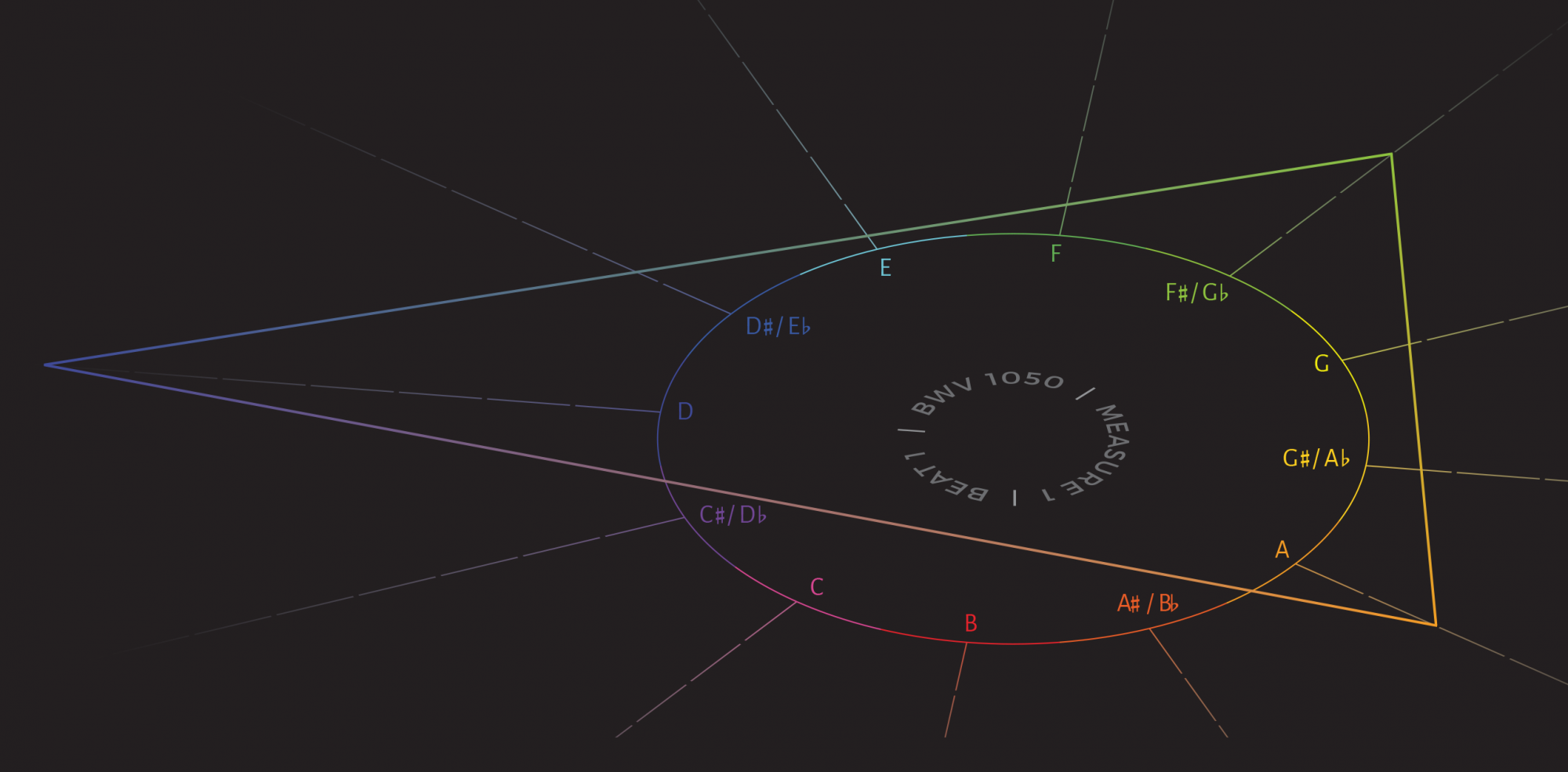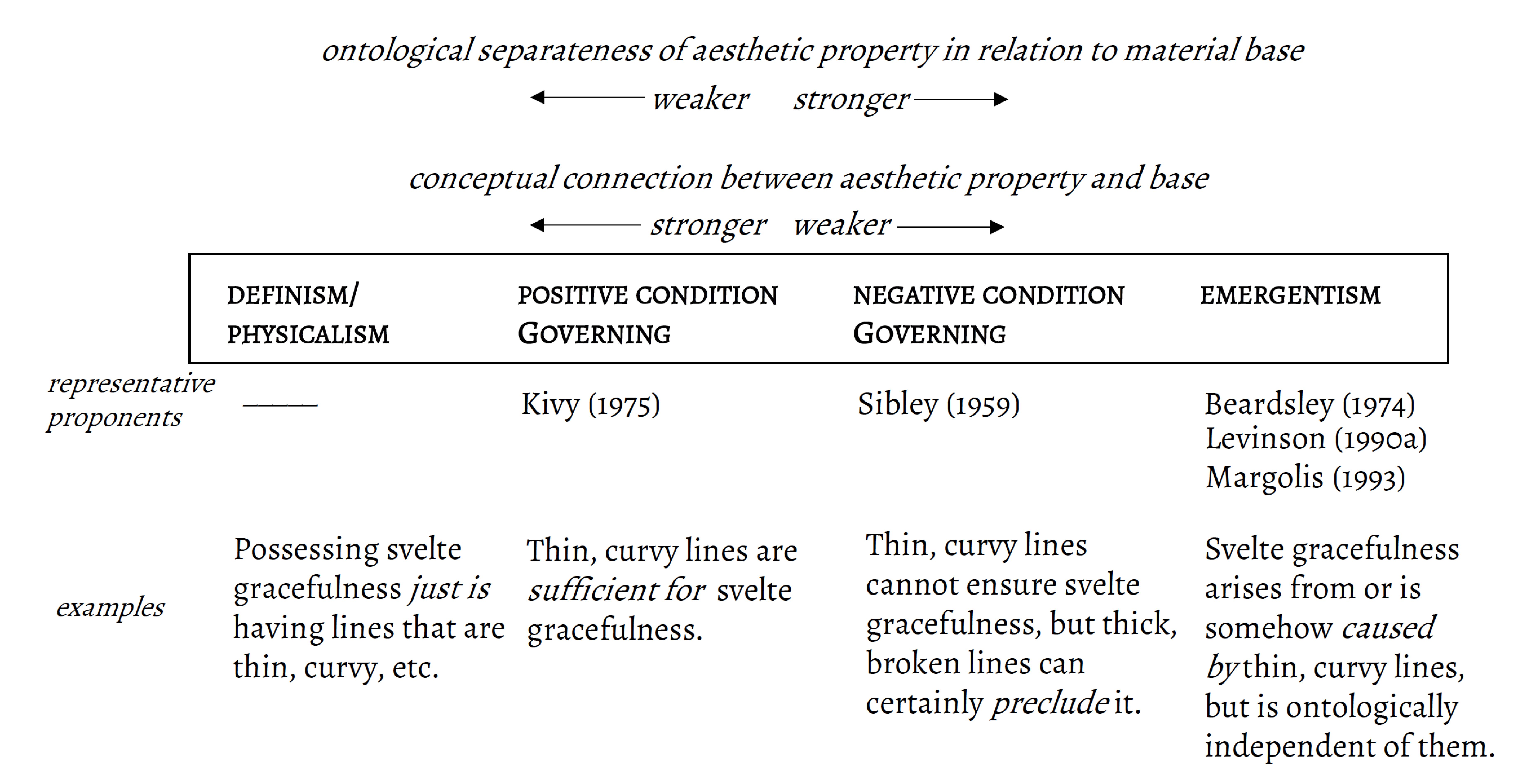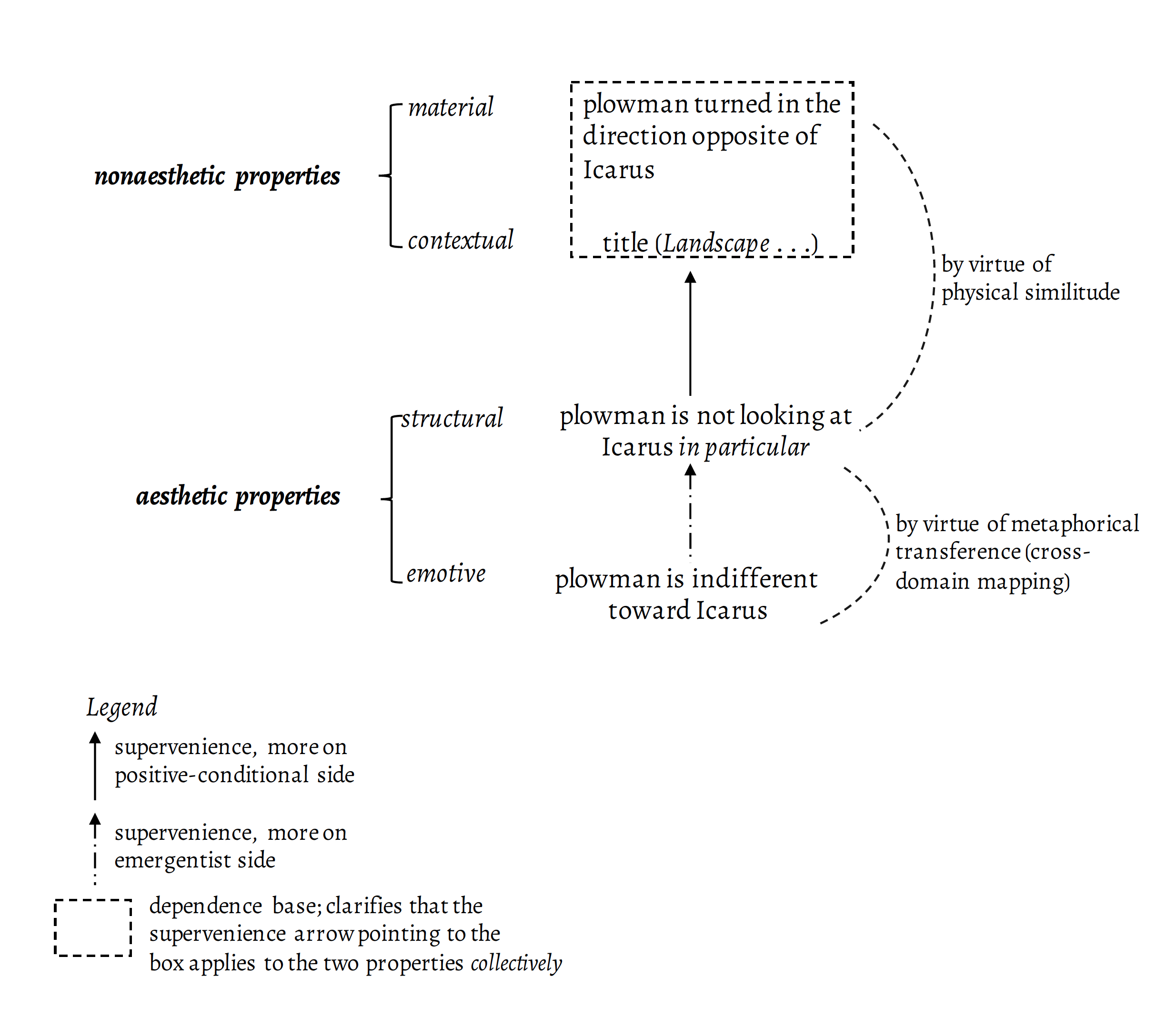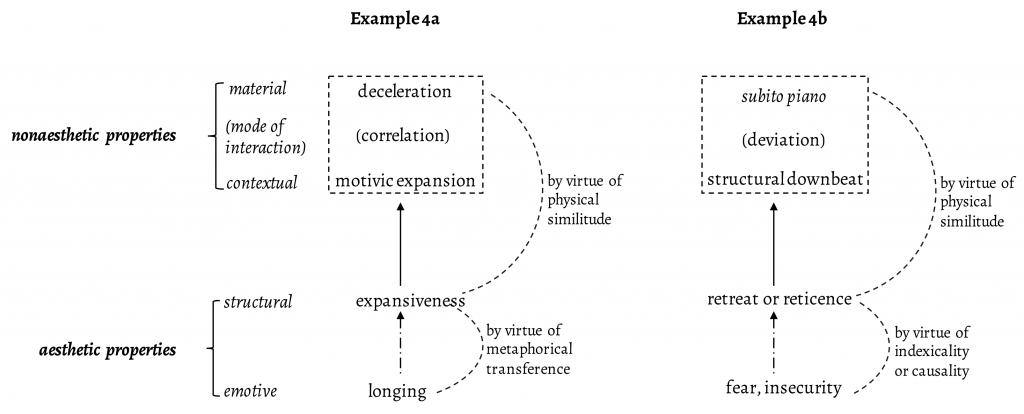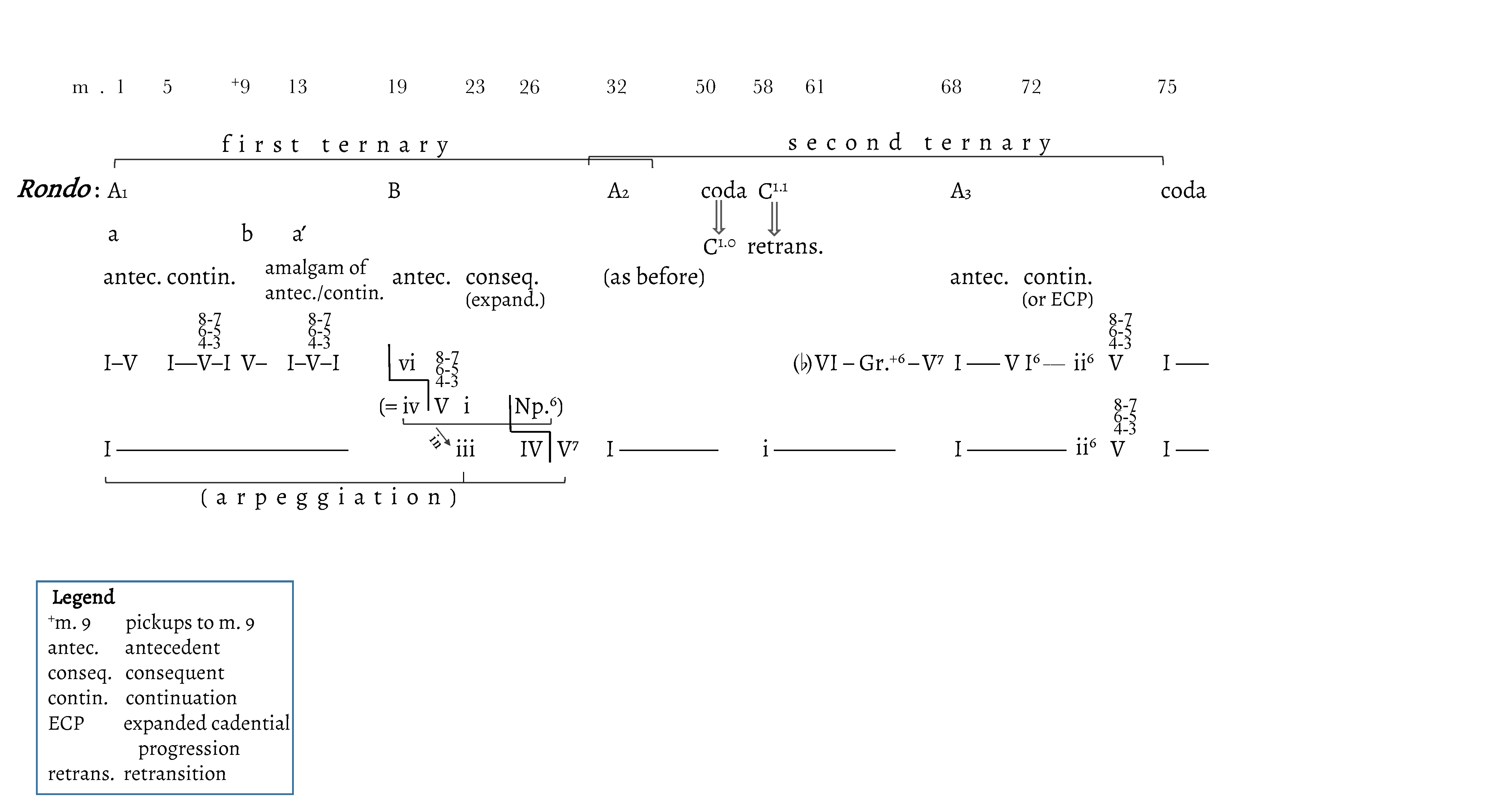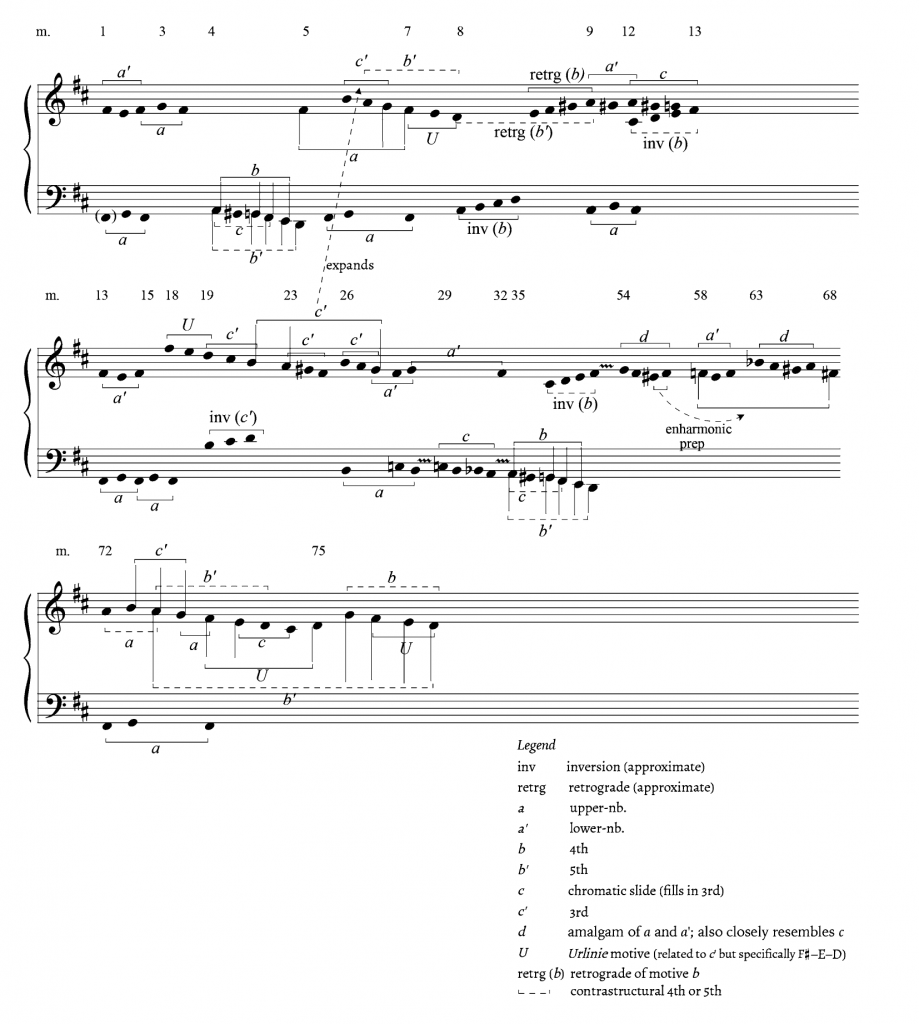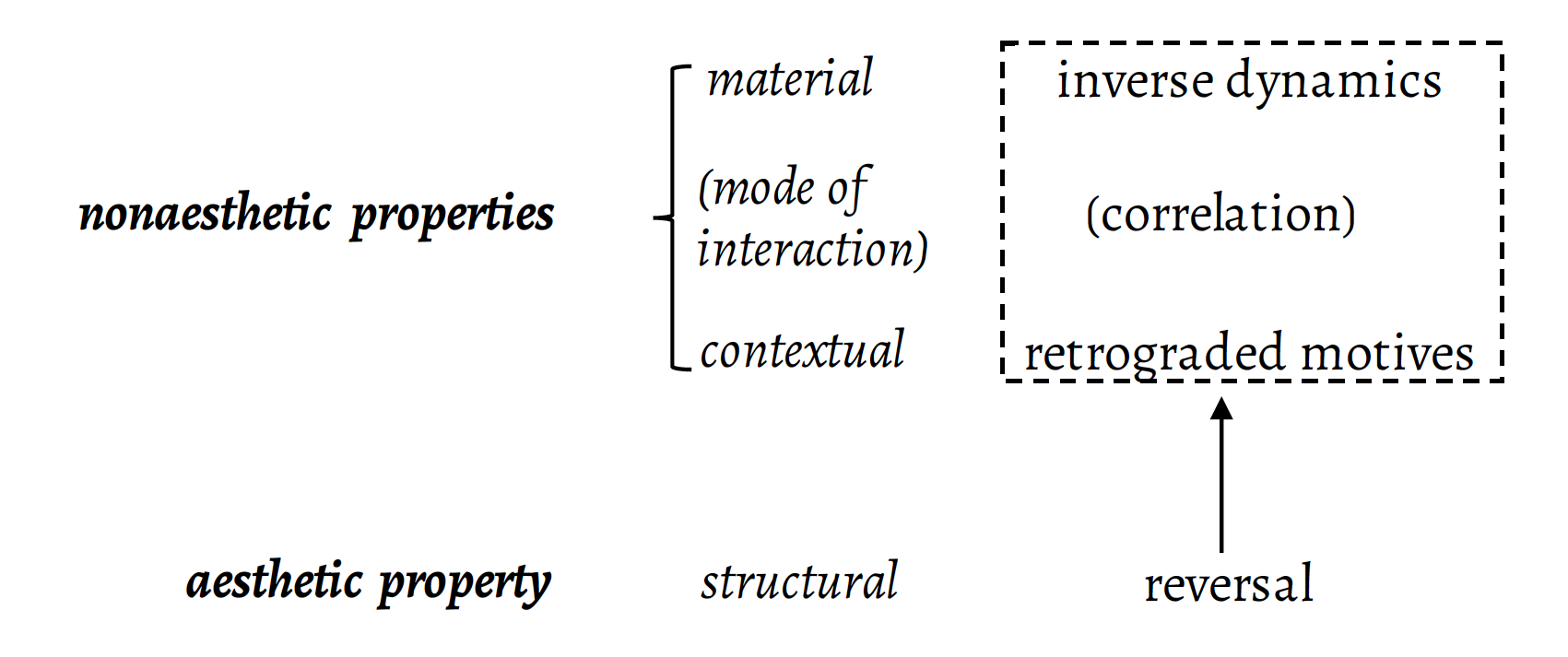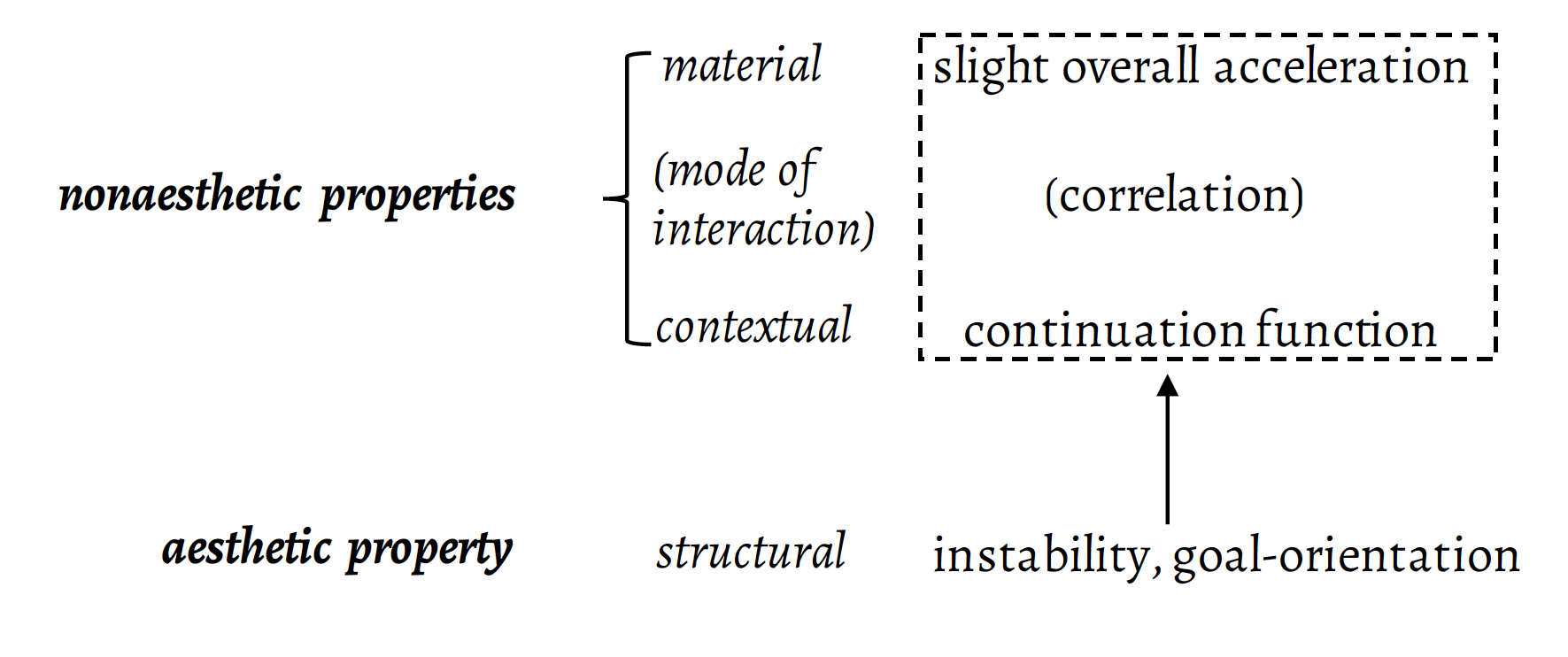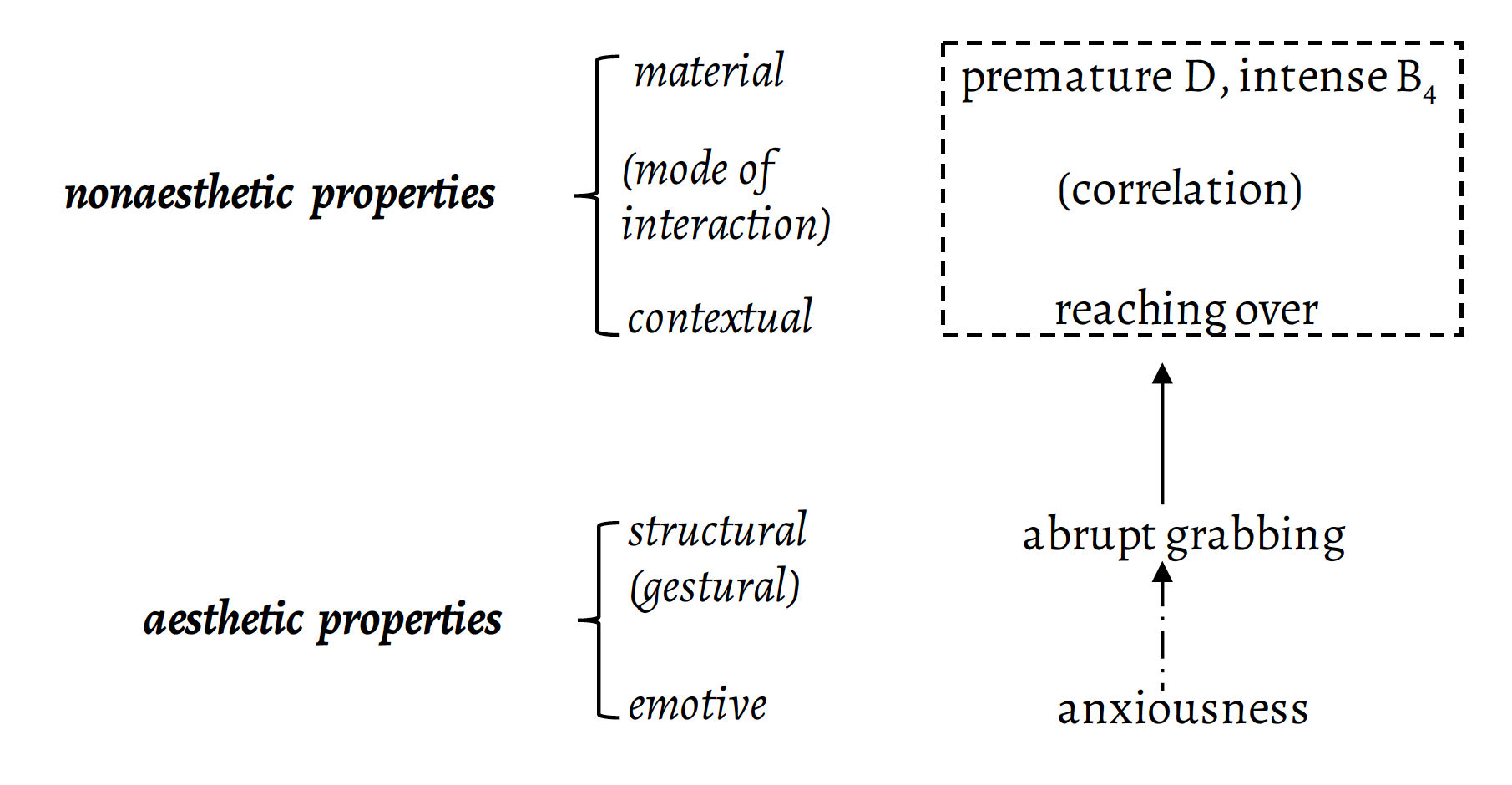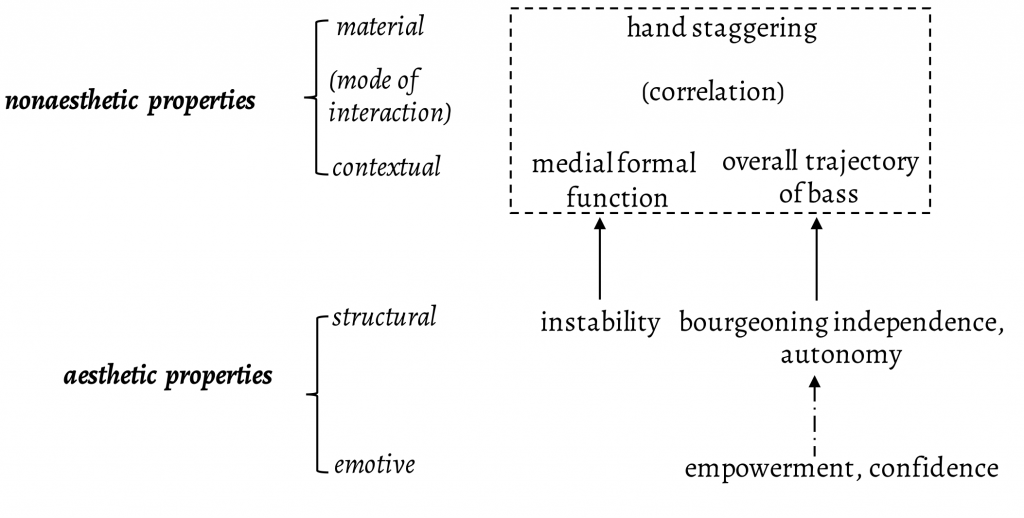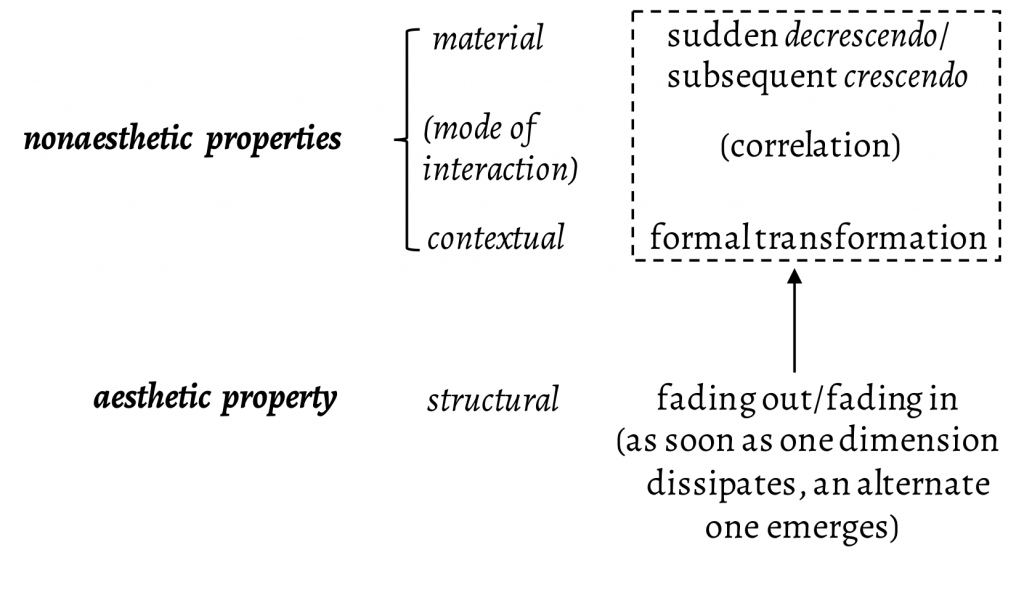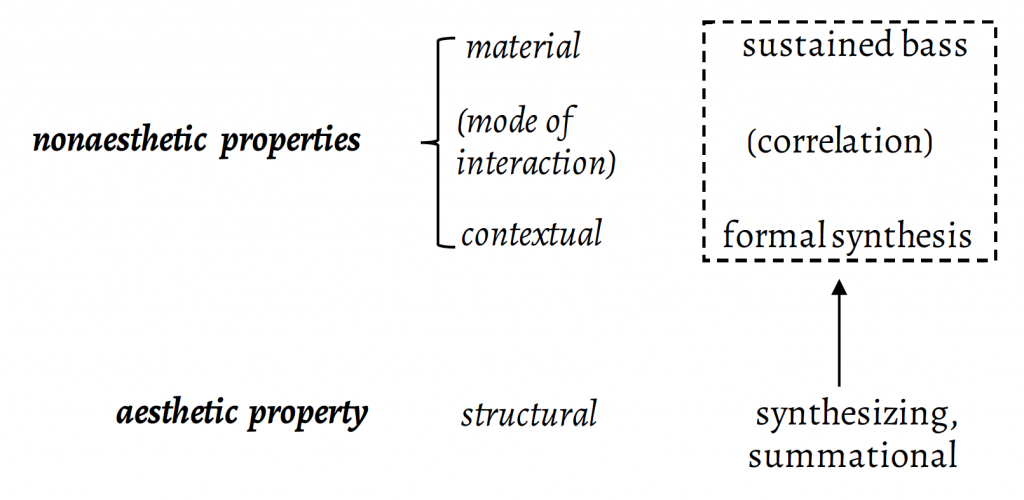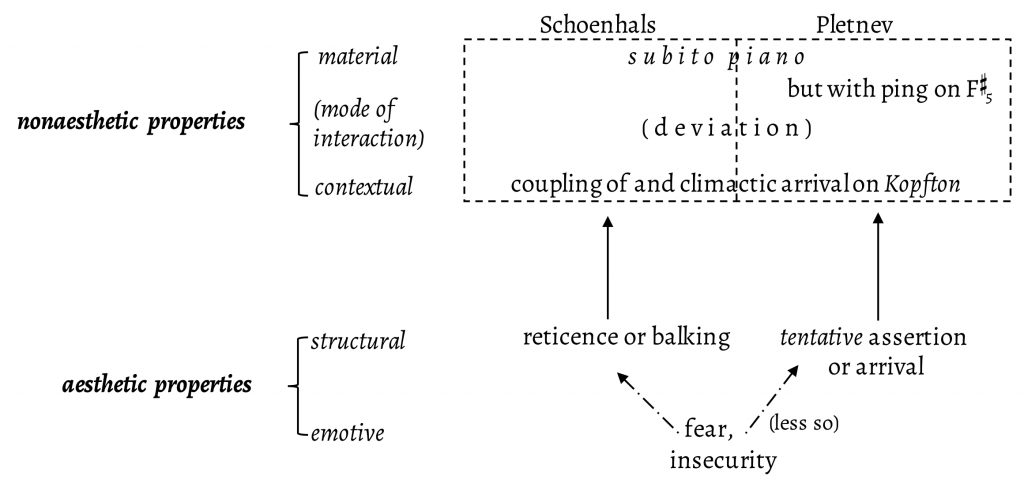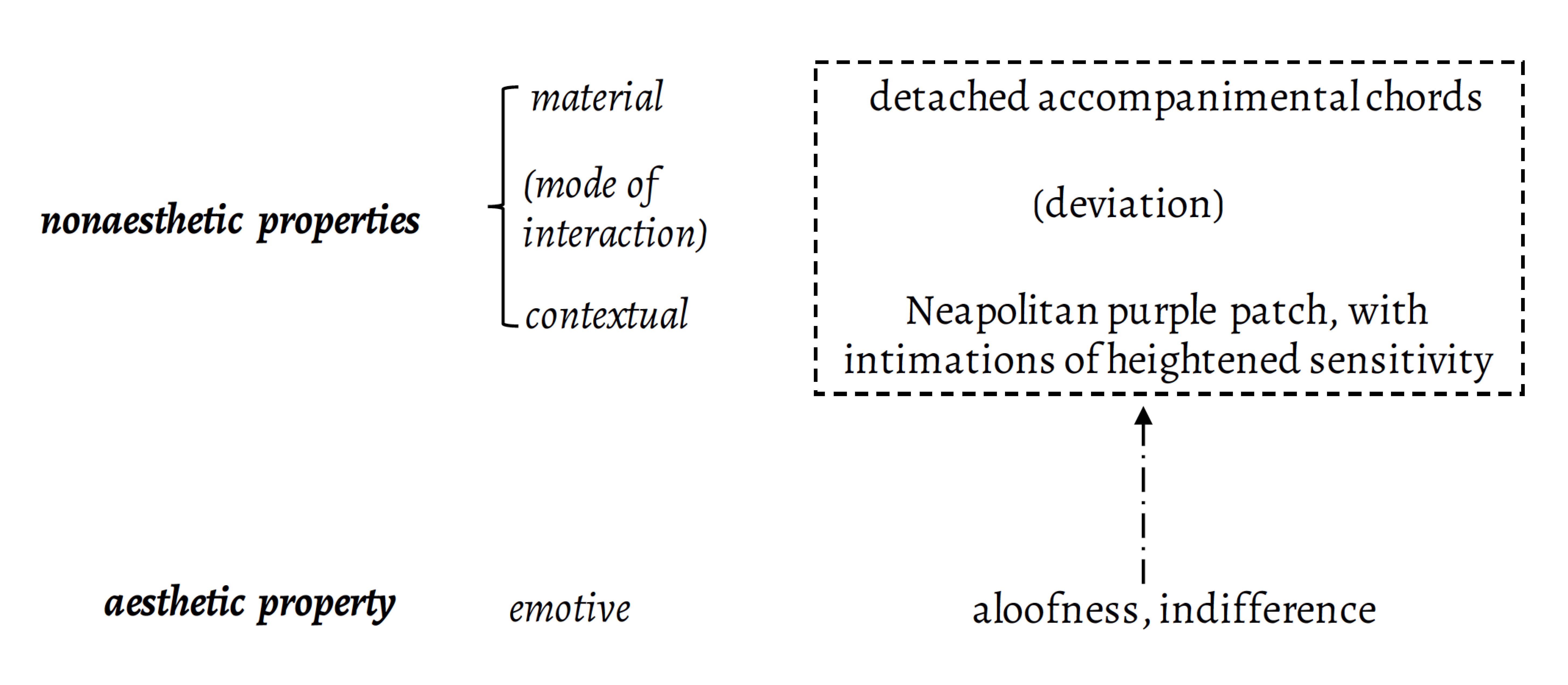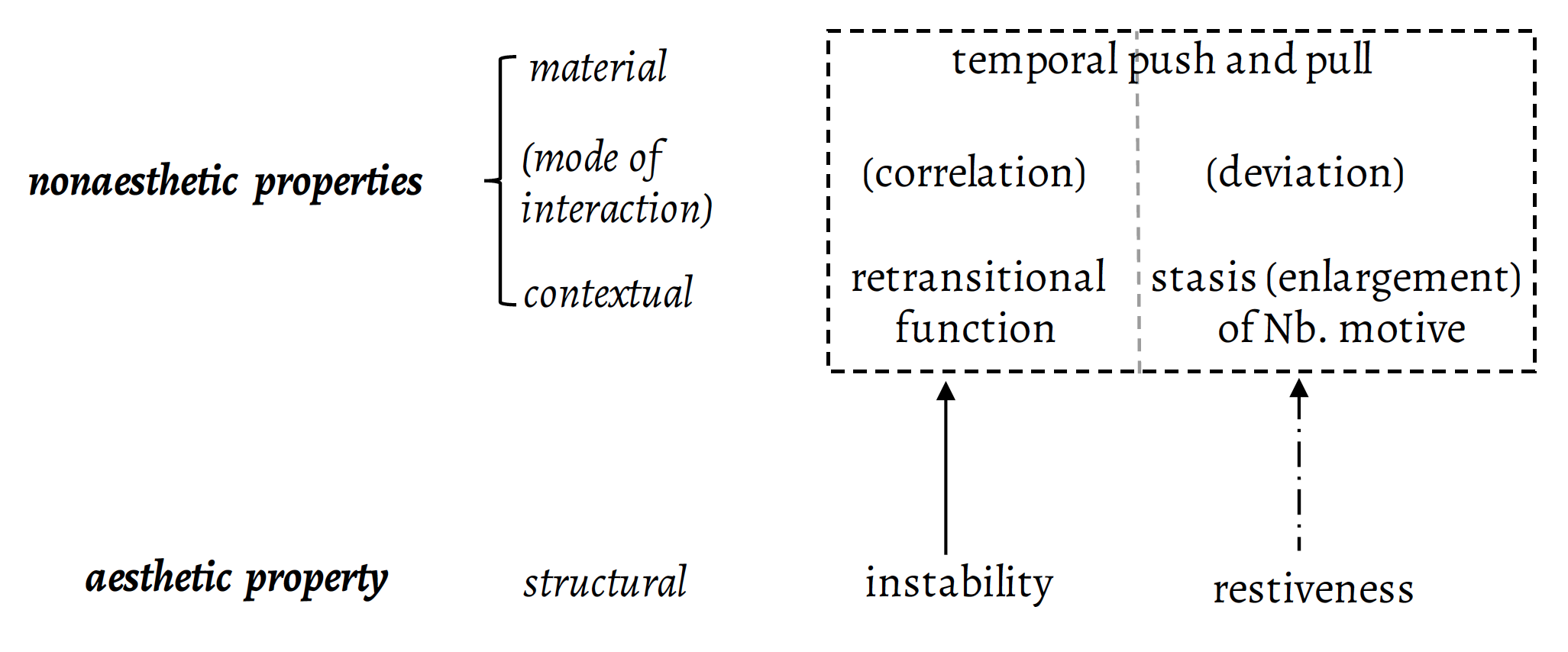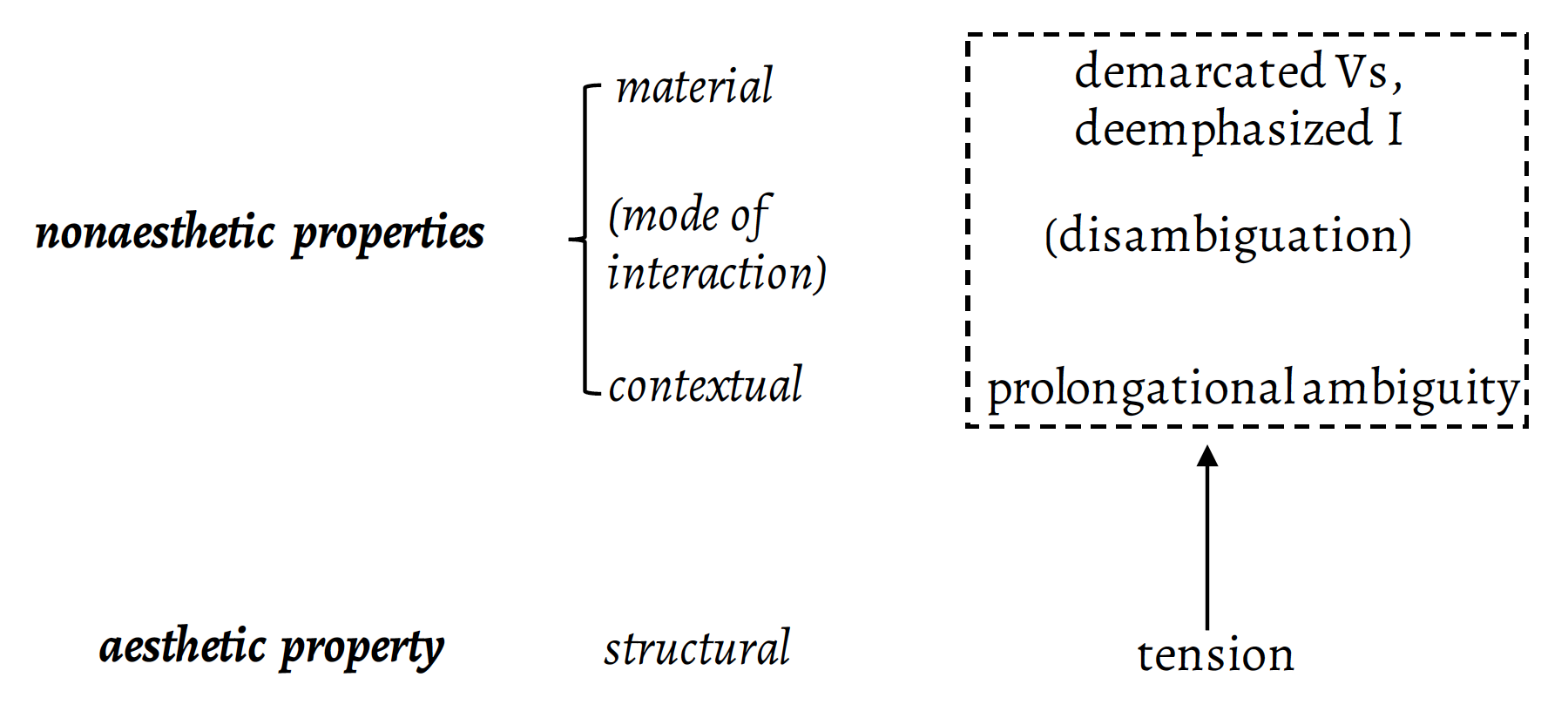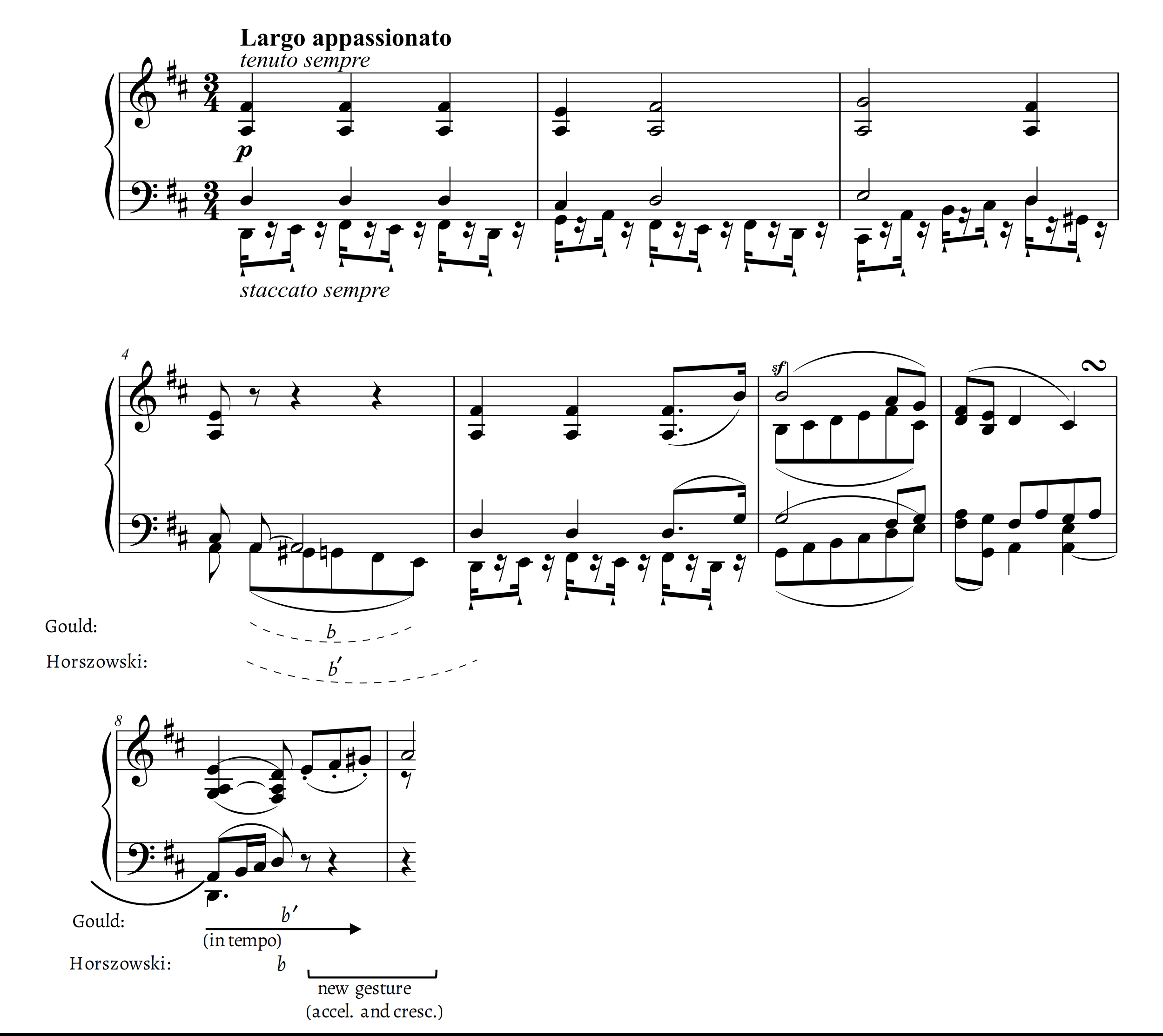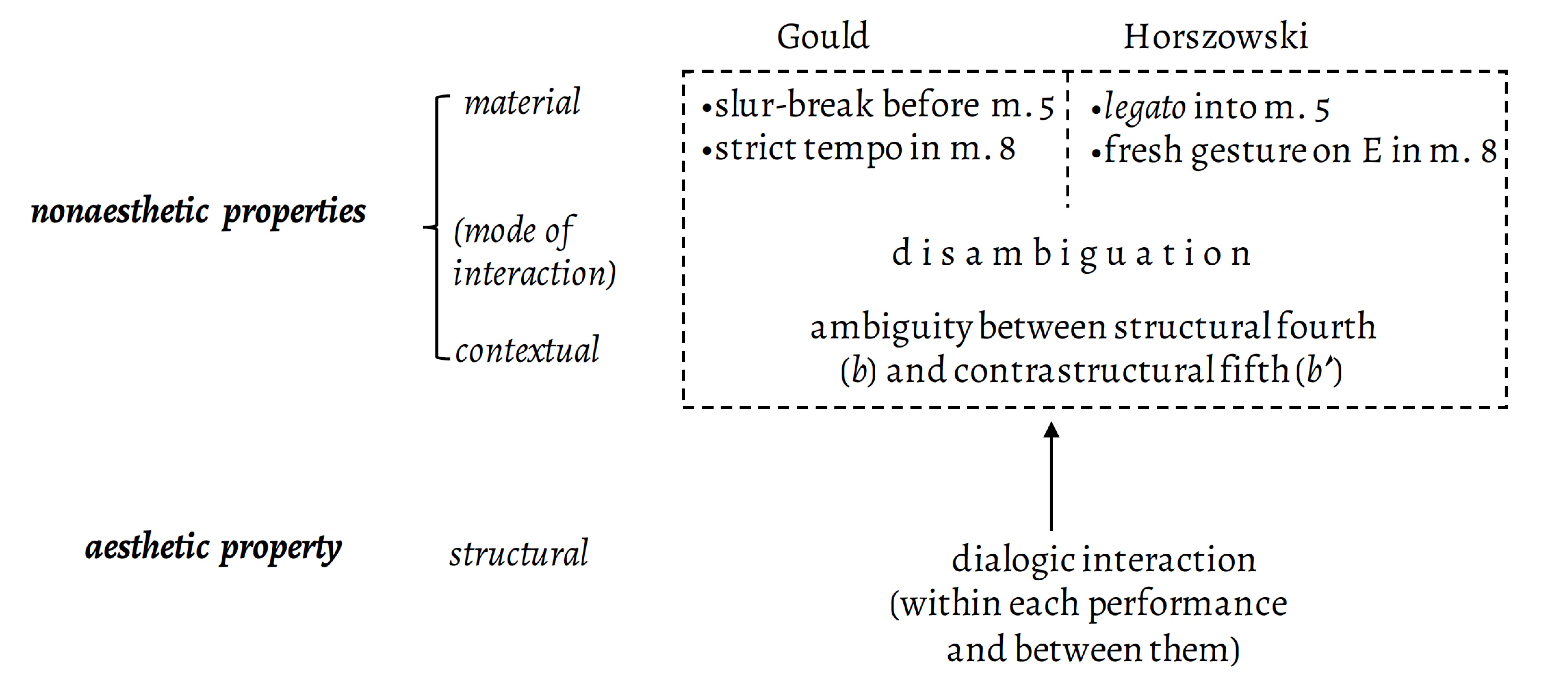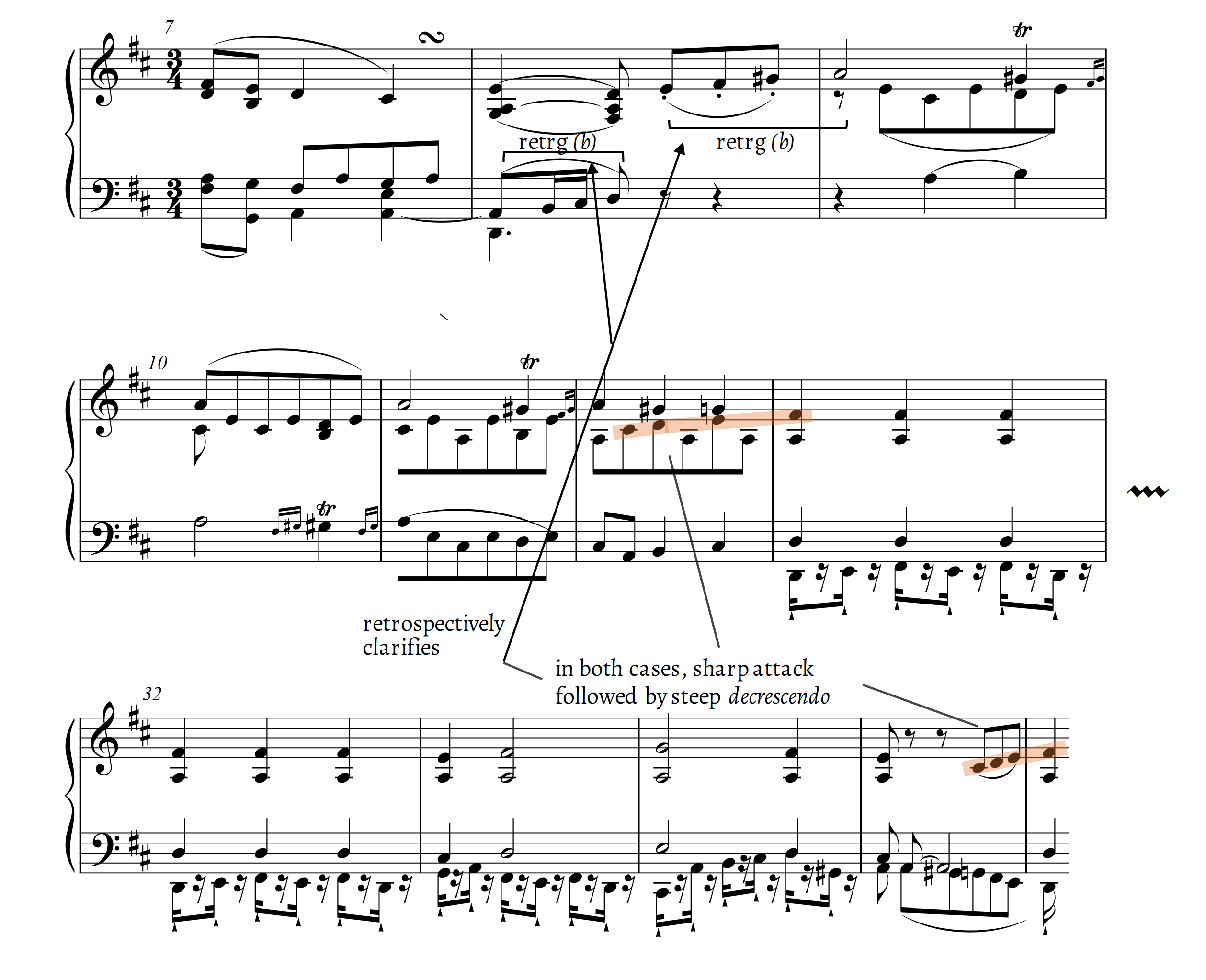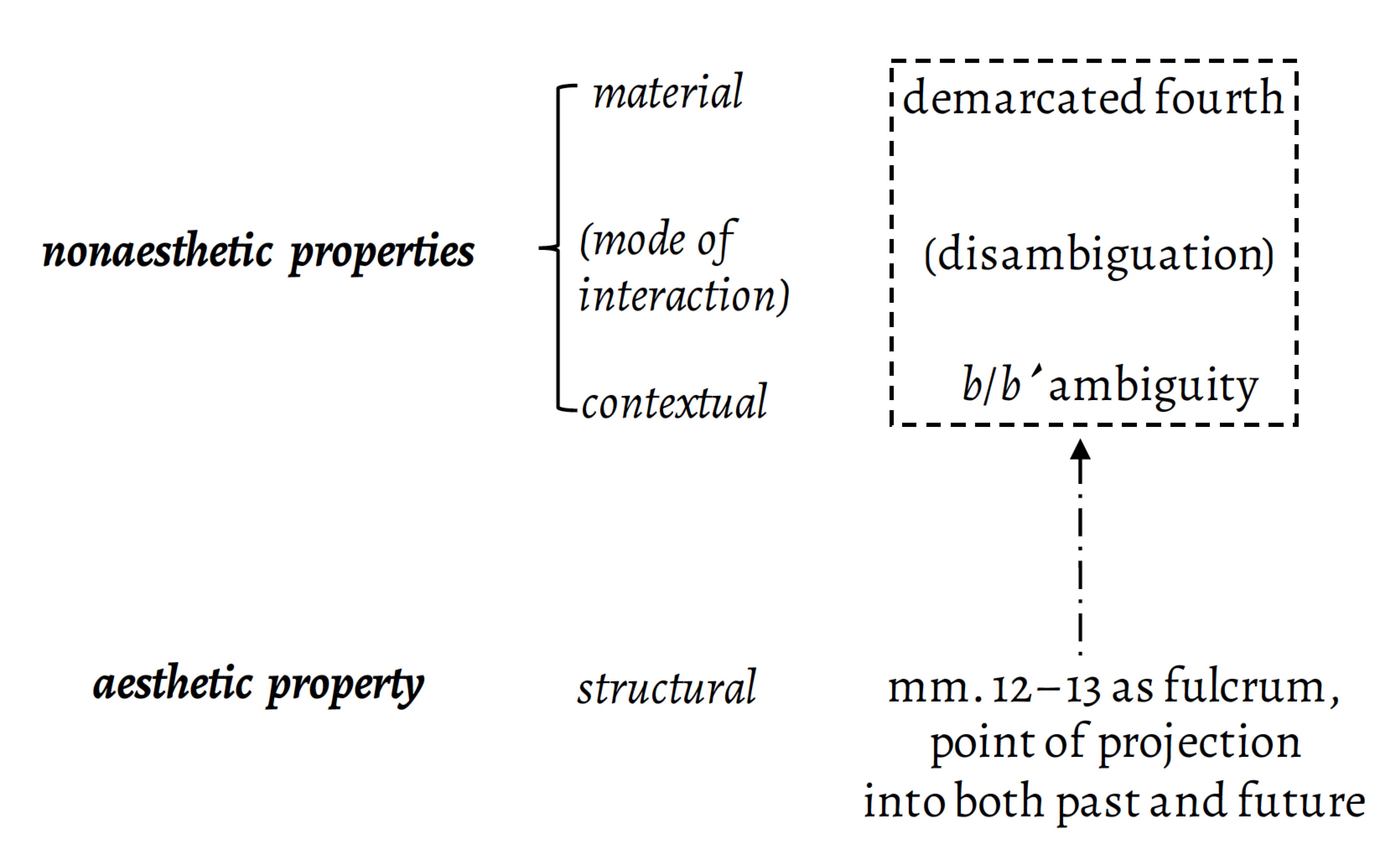Jeffrey Swinkin
Abstract
Just as a score allows for many plausible performative interpretations, so a given performance allows for many plausible hearings. Such hearings are delimited not only by the material features of the performance—its dynamic fluctuations, for instance—but also by the context within which we hear those features. Analysis may comprise one such context. Just as a painting will have different aesthetic features, both formal and emotive, under different titles, so a performance will have different features under different types of analysis, or different readings within a given type. However, a performance does not merely passively receive a context but is heard to interact with it—to correlate with, deviate from, or disambiguate structural events. This article explores six recorded performances of the Largo Appassionato movement from Ludwig van Beethoven’s Piano Sonata in A major, op. 2, no. 2, enumerating aesthetic properties that arise when hearing those performances in the context of formal, Schenkerian, and motivic analyses.
View PDF
Keywords and phrases: aesthetic properties; analytic context; Beethoven, Piano Sonata in A major, op. 2, no. 2, Largo Appassionato; performance and analysis; recording analysis.
Suggested CitationThis article explores how listeners’ analytic awareness of a work might affect how they hear performances of that work.1 My central contention is that the music-structural features adduced by an analysis form a kind of contextual frame. Such a context, like any other—stylistic, programmatic, and so on—is bound to influence the way one apprehends a performance, live or recorded. For, as I shall argue, aesthetic properties do not inhere in the material features of a performance (in dynamic and tempo fluctuations, for instance) but arise from the conjunction of those features and the context in which we place them.
Of the countless pieces I could have used as a case study, I have chosen the second movement of Ludwig van Beethoven’s Piano Sonata No. 2 in A major, op. 2, no. 2, simply because I happen to adore its formal fluidity, harmonic niceties, and motivic ingenuity (all of which I will explicate). And, among the dozens of pianists I surveyed, I chose the six I did—Tom Beghin (playing a period instrument), Glenn Gould, Mieczysław Horszowski, Paul Lewis, Mikhael Pletnev, and Joel Schoenhals—because I find their interpretations delightfully distinctive.
My discussion unfolds as follows. Section 1 specifies the sense in which I use the term “aesthetic properties” and, more generally, adumbrates a method for parsing the interpretive phenomena heard in recordings. Section 2 homes in on the Largo’s salient formal, Schenkerian, and motivic features. Section 3 probes the performances, identifying the aesthetic properties that arise when hearing those performances within the analytic contexts supplied by Section 2. Finally, Section 4 situates the present project within the broader subdiscipline of performance/analysis and attempts to address some of its endemic concerns.
1. Methodology
1.1 Supervenience vis-á-vis Material Properties
Most musicians and listeners intuitively recognize that music can be ethereal, tense, aggressive, bittersweet, exuberant, morose, and so forth. Less intuitively obvious is how such aesthetic properties stem from and relate to music’s material and contextual properties (the so-called dependencebase, or just base). I take that relation to be one of supervenience, which Jerrold Levinson characterizes thus: “Two objects (e.g., artworks) that differ aesthetically necessarily differ nonaesthetically. . . . Fixing the nonaesthetic properties of an object fixes its aesthetic properties” (1990a, 135, his emphases). In this subsection I consider supervenience with respect to material properties and in the next subsection with respect to contextual properties.2
Levinson 1990a lays out the gamut of stances toward supervenience, which I schematize in Example 1. At one extreme lies definism (or physicalism), which essentially equates an aesthetic feature with the material features underlying it. For lines to exhibit svelte gracefulness is just for them to be thin, curvy, and so on. On this view, an aesthetic property is nothing special—it is not qualitatively distinct from its material basis.
At the other extreme lies emergentism (to which Levinson subscribes), which views aesthetic properties as devolving upon material features but as ontologically independent of them. When I see thin, curvy lines, I detect svelte gracefulness, a property that is fundamentally different from thinness and curviness. Put another way, material features contingently cause aesthetic properties but do not logically entail them. Thinness and curviness happen to yield svelte gracefulness but do not necessitate it. In fact, the emergentist must admit that, in principle, that base could have failed to produce that aesthetic property, or could have produced a different one altogether. What emergentism gains in vindicating the uniqueness of aesthetic properties vis-à-vis their material substrata it forfeits in not being able to pin down the precise mechanisms by which aesthetic properties arise from those substrata. Still, Levinson reminds us, “emergentism is not mysticism” (1990a, 146); there is some sort of correlation between the material and aesthetic domains.
Between the extremes of definism and emergentism lies positive condition governing, of which Peter Kivy (1975) is a notable proponent. On this view, aesthetic properties, while not entirely parasitic on material properties, nonetheless depend on them to a high degree. As Levinson explains, “it is part of the meaning of aesthetic predicates . . . that nonaesthetic . . . descriptions are sometimes enough to logically ensure the applicability of an aesthetic description” (1990a, 138). In other words, one can use aesthetic terms on the basis of certain conditions, in which respect they are not categorically distinct from non-aesthetic terms. Kivy pleads his case mainly by dismantling arguments for the opposing view—that aesthetic terms are not condition-governed.3
Finally, still further removed from definism and closer to emergentism is negative condition governing, wherein material features can only preclude the presence of aesthetic features, never ensure it. For example, while thin, curvy lines do not guarantee svelte gracefulness, thick, broken lines definitely disallow it.
I take these stations along the supervenience spectrum to be more continuous than discrete. Thus, for any particular aesthetic property, we should aim to locate its approximate place on this continuum—to assess its degree of conceptual allegiance to material features in relative terms; one should also attempt to specify the basis for that allegiance (see below).
1.2 Supervenience vis-à-vis Contextual Properties
Kendall Walton (1970) has posited that the nonaesthetic base on which aesthetic properties rest encompasses not only material properties but contextual ones as well. The latter he calls categories, which include genre, style, form, medium, and so on. His thesis is, “what aesthetic effect [an artwork] has on us, how it strikes us aesthetically, often depends (in part) on which of its features are standard, which variable, and which contra-standard for us” relative to the category in which we couch it (1970, 343).4 A standard feature is one by virtue of which an artwork belongs to a certain category. A variable feature has no bearing on the category to which a work belongs. Finally, a contra-standard feature counterindicates the category to which a work otherwise belongs. Pictorial representation in painting, Walton explains, depends precisely on the variable rather than standard features of that medium. Indeed, standard features—a canvas’s two-dimensionality, for instance—hardly account for why we see a painting of a given object as resembling that object. Such resemblance instead hinges on the variable features of colors, shapes, and so on. In fact, it is partly because we know which features are standard that we can preclude them from interfering with the business of mimesis. To wit, “a cubist work might look like a person with a cubical head to someone not familiar with the cubist style. But the standardness of such cubical shapes for people who see it as a cubist work prevents them from making that comparison” (1970, 345).
Titles serve as another kind of context. Consider Arthur Danto’s expert exegesis of Pieter Breugel the Elder’s Mannerist painting, Landscape with the Fall of Icarus (Example 2).5 Referring to the flailing legs protruding from the water in the lower-right quadrant, Danto states that they
call for no special explanation, not if, as the title of the picture indicates, it is a landscape. But with the further identification of the legs as belonging to Icarus, the whole work changes. The work will have a different structure than it would have had were you not to have noticed the legs at all, or not to have known they were Icarus’ legs . . . the whole structure of the painting is a function of these being Icarus’ legs. . . . Once we know [they are], as well as information about Icarus himself, we can begin to put the painting together in a way impossible if we lacked that information. You cannot say, for instance . . . that the plowman is not looking at the boy, if the boy is not someone like Icarus in point of tragedy. There are, after all, many things the plowman is not looking at . . . and none of these negative facts is especially . . . compositionally relevant. It is not just that the plowman is not paying any attention, but that Icarus has fallen, and life goes on, indifferent to this tragedy (1981, 116–117).6
Let us restate Danto’s observations in the terms of our present argument. The material features of the painting together with the title (that is, the viewer’s cognizance of the title and myth to which it refers) comprise a dependence base on which these two (among other) aesthetic properties supervene: (a) the plowman is not looking at Icarus in particular; (b) the plowman is indifferent to Icarus’s fate (see Example 3, which I term a supervenience schematic). The former property is more external and spatial; I will term such aesthetic properties structural. The latter is more internal and emotive; I will term such aesthetic properties just that, emotive. Without knowing the title and myth, those aesthetic properties would probably not arise, or at least not be nearly as salient, nor would they if the painting had a different title—say, Plowman by the Sea (Danto’s counterfactual).7
On what basis and to what degree is the attribute of “not looking at Icarus in particular” supervenient? The plowman facing away from Icarus is a patent precondition for that attribute. (At the very least, a negative condition obtains: it is scarcely conceivable that “not looking at Icarus” would be applicable if the plowman were turned toward Icarus—unless, of course, his eyes were conspicuously averted.) Put another way, it is a very short step from “facing away from Icarus” to “not looking at Icarus specifically”—the similarity is obvious. Again, it is on account of the title that “facing away from Icarus” is transformed into “not looking at Icarus.”
As for “indifferent,” I submit that it supervenes most directly on “not looking at Icarus” (it supervenes only indirectly or transitively on the nonaesthetic base) and that this connection is metaphorical. Consider how, in contemporary parlance, “to really see a person” connotes understanding and empathizing with that person; conversely, “to not be seen” connotes not being understood, or being treated apathetically. To state the point more formally, the relation between “not looking at” and “indifferent” is one of cross-domain mapping, wherein the physical (source) domain is transposed onto the emotive (target) domain (Lakoff and Johnson 1980, Zbikowski 2003). Note, the supervenience of this emotive property is nearer the emergence end of the spectrum than is the supervenience of the structural property: the relation between “facing away from Icarus” and “not looking at Icarus” is one of tangible, physical similitude (or approximation), whereas that between “not looking at Icarus” and “being indifferent toward Icarus” is one of abstract analogy.
Levinson would deem the property of not looking at Icarus an intermediate property, an aesthetic base on which the higher-order aesthetic property of indifference is erected (see, for example, Levinson 1990a, 152). This does not attenuate the aesthetic character of the structural property. As Kivy notes, while nonaesthetic descriptions are instrumental, aesthetic ones are either “terminating expressions of feeling”—ones in which we immerse ourselves for no other purpose than to experience them—“. . . or they invite those expressions as the next and terminating step” (1975, 210, my emphasis). I would go further and suggest that in absolute music, structural rather than emotive aesthetic properties are often the terminal properties. Spatial, temporal, and gestural features—these we can and do relish as ends in themselves, no less than we do emotive states. The qualities of being expansive, hurried, tense-then-relaxed, and so on, though sometimes the basis for pointed emotive properties, are frequently the sum and substance of music-aesthetic experience.
1.3 Defining Music-Analytic Context
Musical contexts come in all shapes and sizes. They might consist in listeners’ knowledge of (A) the formal, generic, and stylistic conventions that govern a work; (B) the biographical or wider historical circumstances surrounding the genesis of a work; (C) the title, program, or explanatory notes the composer attached to a work; and (D) a work’s music-structural features as unpacked by a fine-grained analysis, be it formal, Schenkerian, motivic, rhythmic/metric, neo-Riemannian, or others. My essay focuses on this last, music-analytic type of context, considering how it conditions our apprehension of performances. My notion is that an analysis, like a title, can form the contextual component of a base, adjoining the material features of a performance and inflecting them in particular ways; the material features conjoined with an analytic context conduce to ascribing certain aesthetic features to the performance.
To elaborate, analyses, along with titles and others paratexts,8 overlay or frame the musical material, less picking out immanent music-structural features than directing our attention to that material in certain aspects. Analysis is essential and it is not: it is essential in that, once we have adopted an analysis for a piece/performance, it inevitably influences our perception of that piece/performance. It is inessential in that the listener did not need that particular analysis—or any, in fact—to attend to the piece/performance in a relevant way; some other contextual frame might have served equally well, albeit eliciting different perceptions. Similarly, a title or program arguably does not simply point to extra-musical phenomena that the music would depict regardless; rather, it invites us to hear the music in a particular way, to see it in a certain light. It differs from analysis, however, in that—assuming it was furnished by the composer—it is presumably an integral part of the work. As James Hepokoski writes: “a titled character-piece . . . or symphonic poem participates in a tradition wherein the implicit game of intermedial association is presupposed to be aesthetically significant. . . . Composer-intended paratexts . . . are essential for more thoughtful explorations of the layers of connotational and cultural implication that such works invite us to consider” (2014, 67–68).9
Some definitional housekeeping is now in order. Listeners reasonably acclimated to musical norms—tonal, formal, and so forth—will no doubt bring to a performance some music-structural awareness; such awareness, often tacit, will condition their experience of that performance. Music-analytic awareness, as I define it, is more conscious than is structural awareness and also more particularist—it registers a work’s idiosyncratic traits and fairly unique deployment, deformation, and evasion of conventions.10 Hence, listeners can be said to possess music-analytic context not merely by dint of familiarity with relevant norms but by having deliberately adopted a reading of a piece’s particularist treatment of those norms.
That reading may be the listener’s own or someone else’s the listener has studied and embraced. I do not discount the possibility that some advanced listeners might generate an analysis in real time, as the performance unfolds, inductively forming a music-structural narrative at the same time as they hear a performance being shaped by that very narrative. Nor do I discount the possibility that performances can themselves be analytic, in the sense that certain interpretations make evident in sound the same sort of things—prolongational spans, for example—that analyses make evident in notation (see Cook 1995, to which I return below). Such cases, however, do not render the listener’s analytic disposition superfluous. After all, interpretations (analytically-oriented or not) are themselves amenable to interpretations, and analytic listening is a mode—one of many—by which to interpret a performer’s choices.
One of many, indeed. I do not claim that analytic listening is a prerequisite for fruitful listening. In fact, my aim here is not even to advocate for such listening, only to assay a theory of how such listening might work should one choose to practice it. One could expound such a theory by showing how different analyses draw different aural experiences from the same sounding material—for example, how a motivic analysis oriented toward variation and a motivic analysis oriented toward developing variation yield different aesthetic properties (as will divergent readings under either method). Another tactic, which I will employ, is to hold different performances up to the same analytic light and see what properties appear. Naturally, different performances will have different features regardless. The point is to expose the features that uniquely supervene on an analytic context.
1.4 Modes of “Interaction” between Performance and Analytic Context
There is one further factor to consider: music does not merely passively receive the context we apply to it but is heard to interact with it. Music, compared with painting, for instance, is more temporal and thus more animate and thus exudes greater agency.11 This is especially true of performed music, since we readily attribute agency to the performers. They have palpable presence even when unseen (as with audio recordings), because we hear volition and intentionality in the sounds themselves, in how they are shaped. Robert Hatten affirms that listeners typically assume the musical actant (the unspecified source of an action, whether human or non-human) to be the “actual performing agent” and that “even when performers are not physically present to the eye, a sound can still be considered as emanating from an actual source either directly, in the case of the voice, or more indirectly, in the case of an instrument. Those actants are nonetheless actual” (2018, 19). Hence, we hear performances (especially willful, individualistic ones) not as commandeered by contexts but as engaging them. Of course, the performers are not literally responding to listeners’ analytic scenarios (not that we know of), but it is easy to imagine that they are. From such figurative engagement, aesthetic properties arise.
A recorded performance can (figuratively) engage the analytic context the listener brings to bear in several ways, of which this essay will consider three: correlation, deviation, and disambiguation. First, a performance can be heard to correlate with the analysis, to be homologous with a music-structural process. Imagine that one has discovered a motivic enlargement in a certain passage. Upon hearing a performer discernibly decelerate in that passage, one will likely hear that deceleration as homologous with the motivic expansion (without, of course, presuming that the performer consciously decided to decelerate on account of that expansion). As Example 4a illustrates, the material property of deceleration along with the contextual property of motivic expansion with which it correlates comprise a nonaesthetic base. The structural aesthetic property of expansiveness supervenes on that base. (We will later hear Mikhael Pletnev exemplify this scenario.) Its connection to the base is quite strong due to physical likeness; it is a short step from a slower quantity to an expansive quality. Without awareness of the motivic process, one might not hear expansiveness in the ritardation, or might not hear it as acutely. Given another analytic reading (of the motivic content or of another parameter), one might hear some other quality in the ritardation.
Expansiveness, in turn, might in some cases be the terminus, the locus of our aesthetic attention, a quality we take delight in for its own sake. In other cases, it might serve as a base for an emotive quality, such as longing or desire. As with “not looking at Icarus” and “being indifferent toward Icarus,” expansiveness and longing are connected by metaphorical affinity. That is, the image schema wherein it takes a long time to get to or attain something is manifested in the emotive form of longing.12
Second, a performance might appear to deviate either from a music-structural event or from the emotive connotation of such an event. (Remember, contextual properties can be expressive. The Icarus myth contextualizes Breugel’s painting not just in its plot points but also in its pathos, without which we would not conceive the plowman as apathetic.) Envision, for instance, an analysis that posited a structural downbeat, fortissimo, at a certain time-point. Such an event would typically connote a triumphant arrival, an explosive discharge of pent-up energy, or something along those lines. Imagine, further, that a performer pulled back at that point, playing a notch or two below fortissimo. That would likely strike the analytic listener as reticence or retreat from a would-be decisive moment; one might imagine that reticence stemming from fear or insecurity (on the part of a virtual agent). The disjunction between the weak dynamic and (awareness of) the structural downbeat provides a solid base for reticence, especially due to the overt similitude between dynamic softness and reticence. Reticence, in turn, is a base for fear, but a more precarious one, since reticence could be, but need not be, an indexical sign of fear, or fear a cause of reticence. Since the relation is fairly contingent, fear is more emergent than positive-conditional (Example 4b). (We will later hear Pletnev and Joel Schoenhals exemplify this scenario.)
Finally, an analysis will frequently expose some sort of ambiguity in a passage, or the analyst will weigh two contradictory analyses of a passage. In either case, the performer’s dynamic or temporal shaping of that passage might strike the listener as delineating one or the other reading, as disambiguating the music. Suppose, for instance, that one detects competing Kopftöne, $$\hat3$$ and $$\hat5$$, and devises graphs to buttress each contender. The analyst would likely hear a performer who consistently emphasizes $$\hat3$$ (and third-progressions) at the expense of $$\hat5$$ (and fifth-progressions) as disambiguating that piece in favor of a $$\hat3$$-line reading. Generally, a relatively neutral, nondescript rendition of such moments is likely to preserve their polysemy. By contrast, a more decisive or peculiar rendition will likely be heard as projecting one meaning over another. It is also crucial to remember (as stated above) that performances may themselves be analytic or condition our analytic attributions. An analyst might come to a piece having already heard several recordings that delineate fifth-progressions at various structural levels, and thus be subsequently inclined to read the piece as a $$\hat5$$-line, even where $$\hat3$$ might also have been plausible.
1.5 Caveats
Many scholars are understandably wary of conjoining analysis and performance due to a history of writers valorizing the former at the expense of the latter. I meditate on such disciplinary issues in the final section of this essay. For now, I offer a few caveats and clarifications regarding the modes of interaction just enumerated.
First, when I hear a performance correlating with an analysis, I do not equate such correlation with causation (by which analysis is the “cause,” performance the “effect”). Recall how, in the above scenario, the performer broadens the tempo where a motivic expansion occurs. Here there is a clear homology between the performative process and the music-structural process—it makes sense to hear a correspondence between the two. But I do not suppose that the latter is the (or a) basis for the former. Trivially, one can never assume that a performer was conscious of an analytic insight beforehand and was deliberately trying to convey it. Non-trivially, one cannot assume that a Schenkerian reading, no matter how cogent, discloses an intrinsic feature of the piece, such that a cogent performance will necessarily convey that reading, whether or not the performer aimed to. Like Alan Dodson, whom I paraphrase, I interpret performances in terms of their association with Schenkerian and other analyses, pointing to ways in which the performances are heard to correspond with the analyses “without attributing the agreement to some fundamental truth or authority underlying the analysis in question” (Dodson 2008, 110).
Relatedly, when I claim to hear a performative choice in the context of a music-structural feature (as proposed by an analysis), I do not imply that the analysis speaks through the performance to the listener. In the above scenario, a temporal expansion correlates with a motivic expansion but does not communicate it.13 In fact, as Fred Maus (1999) has staunchly argued, performers cannot directly communicate structural notions. For one thing, a single analytic insight can give rise to several divergent performative interpretations and, conversely, a single interpretation can be couched in terms of several divergent analyses. For another, we might think we hear the performance conveying an analytic idea once privy to it, but that is only because we cannot help but hear what we know to listen for. In short, analysis in my model is not something that comes through the recorded performance but something listeners bring to it, if they so choose. An analysis is one possible frame within which we hear a performance; to this extent, analysis serves performance, not the other way around.
Second, does deviation (the second mode of interaction adduced above) entail a self-confirming argument? If we hold that performance relates to an analytic context no matter what the performance does, even when it counterexemplifies the analysis, is that not a heads-I-win, tails-you-lose conceit? That quip comes from Cook (2013a), who spells out the supposed circularity: “If the performance corresponds to the structure, then that confirms the need to understand performance in terms of structure. If it doesn’t, then this deviation confirms the need to understand performance in terms of structure” (55). That concern does not apply here, for, in my estimation, analysis is not a prerequisite for “understanding” a performance, nor the grounds by which to justify it. Moreover, to reiterate, I am not even advocating that we routinely rely on analyses to guide our hearings of performances. I am mainly aiming to demonstrate how analyses, should we choose to adopt them, engender particular hearings of performances.
Furthermore, claiming that music-structural events (or assertions thereof) comprise a context in which certain interpretive phenomena are (to use Walton’s term) contra-standard should not be terribly controversial. After all, we routinely conceive of compositional style and strategy in such terms. It is a commonplace that, once having embraced or assimilated a stylistic frame, we hear the events in a piece of that style as typical or conventional to a greater or lesser degree.14 Few would claim that to view an event as stylistically aberrant is speciously to confirm certain stylistic prejudices. Stylistic conventions render deviations possible, not the other way around. And we tend to relish the marked, idiosyncratic expressions that such deviations entail. I maintain that performance in relation to analytic context works in exactly the same way.
Finally, disambiguation is not necessarily a desideratum; ambiguity has considerable aesthetic merit and it might sometimes be preferable to hear a passage as imbued with multiple simultaneous meanings, affects, relationships, and so on. Hence, where I posit performative disambiguations, the reader should not infer that the music needed to be disambiguated, or that I prefer it that way.
1.6 Summary
1. Aesthetic properties, both structural and emotive, supervene on a nonaesthetic base consisting of material properties, contextual properties, and, at least with performance, some virtual interaction between the two. Different contexts will tease out different aesthetic properties from the selfsame material.
2. Structural aesthetic properties typically enjoy a relatively firm connection to the base, as they usually share with material properties a physical affinity, a relationship of resemblance. When structural properties are not terminal, they in turn provide the base for even higher-level, emotive properties, whose connection to the (aesthetic) base is often looser, since they and structural properties often relate via metaphorical extension or indexical ostension rather than by overt similarity. Emotive properties are thus typically more emergent than are structural properties.
3. Analysis is not a requisite context, but to the extent listeners adopt it, it will invariably affect their experience of a performance; just how it does so is what this article endeavors to explain. Analytic context, as I define it, is more than mere familiarity with relevant tonal and formal schemata; it is a particular reading (or multiple readings) of the work’s music-structural story, as it were—of its peculiar handling of conventions, and the problems the work poses to itself and then proceeds to solve, or not.
4. Recorded performance is not inert where context is concerned; it has virtual agency with which it appears to converse with context, whether in agreement or disagreement, correlation or deviation; it may also referee ambiguities that commonly populate musical structures (or analyses thereof). Performances have aesthetic properties irrespective of analytic context, but still other aesthetic properties arise when such context is applied—that is, when the material facets of a performance engage their analytic environs in various ways.
5. I should add that some scholars deem aesthetic properties literal, others metaphorical. That distinction is minimally relevant here, for in either case, aesthetic properties are real and palpable facets of the listener’s experience.15
2. Analysis
Onto the Largo, then. Example 5 supplies an annotated score, and Example 6 animates that score in sync with my own performance. 16
 Loading…
Loading…
Example 5. Piano Sonata No. 2 in A major, op. 2, no. 2, second movement, Largo appassionato: annotated score.
2.1 Formal
This movement is a five-part rondo, an overview of which is given in Example 7. A1 is a rounded binary (or small ternary). Its a section (mm. 1–8) exemplifies William Caplin’s Hybrid 1: antecedent + continuation (Caplin 1998, 267n4). The second phrase is a continuation rather than a consequent because, in relation to the antecedent, it has mostly different thematic material—only the first two beats are the same—and it appreciably accelerates the harmonic rhythm. The b section (mm. +9–12), barely more than a bridge linking the two a sections, stands on the dominant and trades in simple double counterpoint (see the boxed notes in Example 5).17 a′ is evidently an amalgam of the antecedent and continuation phrases—indeed, this one phrase is roughly the same length as those two phrases combined. Witness how the first two measures (mm. 13–14) are identical to those of the antecedent and the last two measures (mm. 18–19) are identical to those of the continuation (albeit an octave higher and texturally fortified). Between these two points of articulation, there is further and more subtle synthesis. Measures 14–16 fragment the figure that first appeared in m. 2; they thus behave like a continuation—that is, like mm. 5–8—by developing material from the antecedent. What is more, that material fills the F$$\sharp$$–B gap from m. 5, the first event that distinguished the continuation phrase from the antecedent. The gap-fill then overshoots B4, doggedly ascending until reaching F$$\sharp$$5 in m. 18.
The first couplet (B), an expansive period, starts midway through m. 19. The antecedent begins in the relative minor, B minor, which in m. 21 pivots as iv in the key of its own minor dominant, F-sharp minor; the latter is iii at a higher level. Locally, that mediant key sojourns into its Neapolitan in the consequent phrase (see m. 26), in the process generously expanding the antecedent. (Purple patches such as these tend to have either an introspective or other-worldly quality; later, we will hear Glenn Gould upend that expectation.) Due to its minor-mode orientation, I consider the B section a contrasting middle section, an interior theme, within a ternary form comprising the first large section of this rondo (more on which presently).18 A2 is uneventful, save for the hands in its b section (m. +40) reversing roles relative to the first b section: now the bass is the dux, the soprano the comes.
The passage starting in m. 50 has a coda-like demeanor: it prolongs the cadential tonic reached at the end of the previous section; its mood is reflective; and it hearkens back to B-section material—m. 50, for example, is an approximate inversion of m. 23. (It also recalls the small b section, at m. +9, by passing simple one-measure motives among the voices, in the manner of a quaint canon.) Caplin affirms that “the coda of a large ternary frequently refers to material from the interior theme, just as the coda of a sonata often ‘recapitulates’ ideas from the development” (1998, 216). Beethoven could easily have ended the piece on the downbeat of m. 58 with a D-major chord, producing a self-complete ternary piece—but one not nearly as dramatic. Indeed, in lieu of that expected cadence, a stormy and stentorian minor-mode version of the theme erupts. D minor quickly yields to its ($$\flat$$)VI (m. 61), which in turn mutates into an augmented-sixth chord (m. 63) that resolves to V (m. 64). The condensed refrain (A3) starting in m. 68 recuperates the sixteenth-note stream that coursed through mm. 50–57. The first measure of the continuation (m. 72) alters the melody relative to the previous continuations, now departing from $$\hat5$$ instead of $$\hat3$$. (One might view this phrase as describing an expanded cadential progression, in which case it would be cadential rather than continuational.19) The end of the refrain overlaps with the onset of the coda in m. 75.
In light of the abandoned closure in m. 58, how are we to understand the formal function of mm. 50–57? Measures 58–67, in centering around the home key’s parallel minor, behave like the contrasting middle section of a ternary form. As a consequence, one might retrospectively hear the section starting in m. 50, which initially displays coda-like comportment, as belonging to a contrasting middle section spanning mm. 50–67. This reading of mm. 50–57 is supported by the fact that its sixteenth-note figuration, as mentioned, is adopted and adapted by the next refrain (A3) and it is typical for a ternary’s reprise to assimilate some rhythmic or textural element of the contrasting middle. Measures 58ff. also prove vulnerable to formal slippage: although the section begins in a thematically and tonally stable manner, it soon gives way, starting in m. 60 or m. 61, to retransitional rhetoric. Witness the unstable harmonies ([V]–($$\flat$$)VI–Gr.+6–V) and liquidating scalar material. The ostensible minor-mode thematic statement turns out to be a house of sand. Hence, while its first two measures retroactively metamorphose the previous section (at m. 50) from a coda into part of a contrasting middle (perhaps a preliminary module thereof—hence the C1.0 designation), the next few measures (mm. 60 or 61ff.) retroactively metamorphose the contrasting middle into a retransition. These formal dialectics are illustrated in Example 5.20 How might awareness of this formally fluid process spanning mm. 50–68 influence how we hear performances of these measures? What might a performative correlate of that process sound like? Pletnev and Schoenhals will soon show us.
In summary, I view this rondo as comprising (or arising from) two overlapping ternaries (see Example 7), which is how Heinrich Schenker conceives the five-part rondo generally.21 Unlike Schenker, I do not think that five-part rondos are necessarily best understood as two conjoined ternaries; however, this one appears to be, precisely because Beethoven clearly signals closure in m. 57. That is, he gestures toward a single ternary but balks at it at the last minute, opening up a second ternary path.
Incidentally, Schenker views this movement as not a five-part but a nine-part rondo, as evident in his voice-leading graph, shown in Example 8 (see the letters in-between the staves).22 This reading hinges on Schenker regarding a′ within each large refrain as its own, separate refrain. This interpretation was suppressed in all editions of Der freie Satz subsequent to the first, as Oswald Jonas apparently deemed it misconceived.23
 Loading…
Loading…
Example 9. Author’s middleground graph.
2.2 Schenkerian
Example 9 gives my voice-leading analysis, which is essentially a shallow-middleground elaboration of Schenker’s deeper middleground, pictured in Example 8 (I will point out a few differences between our readings as we proceed). Example 10 animates the graph in sync with my performance. I have chosen to focus mostly on middleground structure because Schenker, as is well known, expressed reservations about projecting the background in performance; he admonished the performer not to follow “the Urlinie slavishly and pluck it out of the diminution, just to communicate it to the listener” (1994 [1925], 109). Yet, he did favor projecting middleground phenomena, such as motivic parallelisms: “In view of the fact that the masters based their syntheses mainly upon such [motivic] relationships, there can be no doubt of the importance of projecting them—it remains only to find the specific means of achieving such projection” (1979 [1935], 100).24 What goes for performers might go for perceivers as well: instead of listening for the Ursatz in performances, we might more fruitfully listen for middleground motives and progressions and their resonances at the foreground.
Measures 1–8 house a transferred Ursatz, which is initially interrupted and then completed. Note that Schenker, in an unpublished sketch, reads the soprano’s F$$\sharp$$ in m. 3 as passing between G and E, as a consequence of G coinciding with the dominant divider (downbeat of m. 3).25 I find this interpretation dubious since that downbeat dominant is in $$6\atop5$$ position. The root position does not arrive until m. 4, which is thus where I place the divider. That said, some prolongational ambiguity might be present (see the brackets in Example 5), one we will later hear Gould “resolve.” Such ambiguity also permeates mm. 6–7: I see the tonic chord on the third beat of m. 6 as non-functional, as passing between the root and third of a viiø7 chord. Alternatively, one might see that tonic chord as more structural and as composed-out over the bar by way of a passing chord. Example 5 spells out this ambiguity, one we will later hear Tom Beghin “resolve.”
Returning to Example 9, in a′ the Kopfton $$\hat3$$ is treated expansively and grandiosely: it is octave-transferred (F$$\sharp$$4–F$$\sharp$$5) across mm. 13–18. This climactic coupling opens up space for additional, phrase-expanding motivic content—the aforementioned fragmentation. A descent to $$\hat2$$ and $$\hat1$$ follows, bringing the entire refrain to a close. In the B section, both Schenker and I assert an auxiliary cadence within iii, which itself belongs to a broad I–iii–V arpeggiation (Examples 8 and 9). In the passage beginning at m. 50, Schenker posits a largely undifferentiated D5–D4 octave descent, one slightly subdivided at F$$\sharp$$. I instead adduce a fifth-progression, A–G–F$$\sharp$$–E–D, which is auspicious for closing off the first of the two interlocking ternaries. That sequence of pitches recurs in the continuation phrase (m. 72)—as we have seen, it launches from A rather than the expected F$$\sharp$$. As such, the final melodic descent prior to the coda might sound to some like $$\hat5$$–$$\hat4$$–$$\hat3$$–$$\hat2$$–$$\hat1$$. And lest we miss the point, Beethoven displaces the sforzando, which before belonged to A’s upper-neighbor B (as in m. 6), to the A itself (m. 73, third beat).26 Structurally speaking, however, $$\hat3$$ is still in charge and is embellished by the preceding $$\hat5$$ and $$\hat4$$.
2.3 Motivic
Example 11 provides a motivic synopsis of the movement, which features three motivic families: neighbor figures (a), fourth- and fifth-motions (b), and third-motions (c). The upper-neighbor motive (a) spans the bass’s first two measures and is counterpointed by a lower-neighbor motive (a′) in the soprano. In m. 3, a decamps to the soprano before dutifully returning to the bass in m. 5. Here, as seen in Example 9, the G neighbor is composed-out by motion into an inner voice before resolving to F$$\sharp$$ on the downbeat of m. 7; a is thus enlarged.
The lead-in figure in the bass of mm. 4–5 juxtaposes a fourth (b), which is a structural motive since it falls within the A-major dominant divider, and a fifth (b′), which is contrastructural since it bleeds through that harmonic boundary. The fourth is delineated by Beethoven’s slur, while the fifth is salient simply due to the unbroken stepwise succession—it is difficult not to hear the E in m. 4 continuing to the D in m. 5. The lead-in figure in the soprano of mm. 8–9 is similarly bifurcated: it juxtaposes an approximate retrograde of b (E–A) and that of b′(D–A). Here too the fourth is delineated by articulation, while the fifth is salient due to rhythmic contiguity (D in m. 8 is closer to the following E than to the previous one). Hence, both mm. 4–5 and 8–9 are subtly ambiguous as to which motive takes perceptual precedence—the structural fourth (b) or contrastructural fifth (b′).27 We will hear Gould and Mieczysław Horszowski “weigh in” on these ambiguities.
In the B section, B4 and A4 prefix the G neighbor, which is reintroduced in m. 26 within the Neapolitan purple patch. The entire section is a magnificent expansion of mm. 6–7, where B4 and A4 reached over the G neighbor (see both Examples 9 and 11). Here in the B section, that third-progression is ramified, with B and A each spawning a smaller-scale third-progression. B4’s progression fills in the third above it (D5–C$$\sharp$$5–B4, mm. 19–20 and its repetition); A4’s progression fills in the third below it (A4–G$$\sharp$$4–F$$\sharp$$4, mm. 22–23 and its octave-displaced repetitions).
Also notice c, which commands the bass in mm. 29–31. The germinating seed of c was the bass of m. 4, where it lay latent within b/b′. Its first notable appearance was in the soprano of mm. 12–13, where it rang in the small reprise (a′). Here, in mm. 29–31, it rings in the large reprise (A2).
To this point (the onset of A2), we have seen the a motive progressively expanded; as shown by the brackets in Example 9, each expansion is longer than the previous. Its longest iteration spans some 13-plus measures (mm. 19–32). (Bear in mind, a here lacks the initial F$$\sharp$$, which is in a sense replaced by B4 and A4, which prefix the G.) Indeed, by A2 that motive is spent and so it is unsurprising that the next couplet turns its attention to something else—namely, the semitone lowering of $$\hat3$$, by means of modal mixture.
Incidentally, note that the middleground F$$\natural$$–F$$\sharp$$ is enharmonically prepared in the alto of m. 54 and the soprano of m. 55 and is echoed in the bass of m. 72 (see Example 5). The enharmonic foreshadowings are ensconced in the broader figure that is motive d (mm. 54–56). d is a deceptively simple amalgam of three different motives: a (the G upper neighbor), a′ (the E$$\sharp$$ lower neighbor), and c (the first three pitches, which chromatically descend). Perhaps this section partially owes its closural quality to the summational nature of those figures.
Finally, as discussed, the final phrase prior to the coda (at m. 72) curiously departs from $$\hat5$$ rather than $$\hat3$$. While the structural status of $$\hat3$$ is never truly in doubt, there is at least some superficial obfuscation resulting from that $$\hat5$$ and the contrastructural b′ motive it triggers (see the bottom system of Example 11). That mild ambiguity will influence how we hear Beghin’s and Gould’s performative maneuvers. In any case, that phrase at m. 72 and the coda summarize many of the main motives in this movement—all three motivic families are represented. Most significant, however, is the reiteration of the Urlinie motive (U), which is a pitch-specific form of the more general c′ motive.
3. The Performances
For the sake of clarity, I will explore each mode of interaction—correlation, deviation, and disambiguation—independently, tracing instances of each more or less chronologically.28
3.1 Correlation
Gould and Horszowski each render the linking figure in mm. 4–5 with a sharp decrescendo, its (approximate) retrograde in mm. 8–9 with a sharp crescendo (Audio Example 1 features Horszowski). Gould and Horszowski match inverse forms of the figure with inverse dynamics, offering to our analytic ears a dynamic analogy for a contoural relationship. Getting louder on ascending lines and softer on descending ones is a common and conventional tactic, one that can potentially assume any number of aesthetic properties. Here, given our awareness of the retrograde relationship, that dynamic scheme arguably assumes the structural aesthetic property of reversal. That is, the crescendo “reverses” the decrescendo because the motive to which the former is attached reverses the one to which the latter is attached. Hence, a material facet of the performance and cognizance of a motivic relationship together yield an aural aesthetic quality (see Example 12) (Note, the aesthetic property here is virtually identical with, or reducible to, the nonaesthetic properties; hence, the supervenience here is definist—review Example 1).
As evident in Audio Example 2, Paul Lewis plays mm. 5–8 slightly more swiftly (approximately ♪=82) than he does mm. 1–4 (♪ = 76). (Gould, by contrast, meticulously maintains a near-even tempo across mm. 1–8.) Such acceleration correlates with the continuation function of that phrase, since continuations are chiefly characterized by faster harmonic rhythm (which obtains here) and a faster rate of motivic repetition (which does not). Additionally, continuations have an unstable quality; “it is precisely the function of the continuation to destabilize the formal context established by the presentation and to give the theme greater mobility” (Caplin 1998, 41). Such mobility, I should add, is usually in the service of actively seeking out a goal; continuations are decidedly linear and teleological. Hence, Lewis’s acceleration, heard in this form-functional environment, assumes the aesthetic properties of instability and goal-orientation (Example 13). Absent the formal context, one might hear the acceleration in purely quantitative terms, or as imbued with aesthetic properties other than the ones just mentioned. It is also conceivable that, even without the context, one would hear those properties in Lewis’s relative rapidity. But, at the very least, the context strongly conduces to such a hearing, or perhaps renders those properties more salient than they would otherwise be.
Elsewhere, I have speculated that certain Schenkerian phenomena are metaphorical extensions of physical (and affective) experiences (Swinkin 2016). Tonal prolongation, for instance, is plausibly the product of cross-domain mapping: physically clinging to something amidst surrounding changes maps onto the aural retention of a tone or chord while others are sounding. Schenker characterizes such aural retention as “conceptual tension [geistige Spannung] between the beginning and the end of the span: the primary note is to be retained until the point at which the concluding note appears” (1996 [1926], 1, my emphases). His emphasis on tension affirms that a somatic schema undergirds tonal prolongation. Likewise, reaching over (Übergreifung) is arguably a metaphorical extension of physical stretch and strain. In the Largo, reaching over occurs as early as m. 6, where the melodic line overshoots G4 of the F$$\sharp$$–G–F$$\sharp$$ neighbor motion (motive a—see Example 9). Schoenhals’s treatment of that B4, under the auspices of my analysis, is a pianistic parallel to that reaching over. As evident in Audio Example 3, he plays the bass’s D at the very end of m. 5 prematurely and then lunges at the soprano’s B4 in m. 6. This conjures an image of the ground suddenly slipping out from under someone who thus anxiously reaches for something overhead, like a tree branch, to hold on to. (Granted, Schoenhals might have momentarily lost control here, but that does not necessarily alter the aesthetic impact.)
If Lewis’s rendition of mm. 5–8 correlates with their continuation function, Pletnev’s rendition of mm. +9–12 (Audio Example 4) correlates with their medial function. Namely, he displaces or staggers his hands more obviously and frequently than he does in the framing sections, as if to shake loose their somewhat stiff metrical mien. (I shamelessly mimic that tactic in my own rendition.) The metrical dissonance between the hands confirms and conforms to the harmonic dissonance (standing on the dominant) and corresponding formal instability. What is more, the staggering also helps individuate the voices, especially the bass and its A–B–A in mm. 9–10.29 That is significant given the broader context: mm. 1–8 resemble nothing so much as a string-quartet ensemble whose cello in mm. 1–3 and 5 is relegated to a whispery, pizzicato accompaniment. In m. 6, that voice, pursuing the idea planted in m. 4, starts to shed its subservience with a more mobile, melodic line (which the alto shadows a tenth above). Then, starting in m. 9, the bass really comes into its own with an A–B–A figure that rendezvouses with the A–G$$\sharp$$–A in double counterpoint (see the boxed notes in Example 5). (This section distills and develops the interchange between motives a and a′ of the previous section.) The bass is even more fully actualized in A2, where, as we have seen, it reverses roles with the soprano, now playing dux to the soprano’s comes. Pletnev’s treatment of the bass in mm. 9–10 is thus heard not merely as local emphasis but as affirming the bass’s bourgeoning autonomy, on which perhaps the emotion of empowerment (or the attribute of “feeling empowered”) supervenes (Example 15).30
In approaching m. 18, Pletnev practically grinds to a halt (Audio Example 5). Recall that motive a stretches from m. 13 to m. 18 in both the soprano and the bass (Example 9). The listener who is privy to that motivic expansion will likely hear Pletnev’s slowness as expansiveness. Pletnev makes it easy to relate his ritardando to the motivic event since he takes time on the G neighbor (in the bass at the end of m. 17) in particular. We thus see the hypothetical scenario presented in Section 1.4 and Example 4a exemplified. (The emotive aesthetic property of longing identified in that example might apply here as well, but I shall posit another emotive aesthetic property later on.) Even without the analysis, one might hear the deceleration as expansiveness. However, the analysis definitely promotes that hearing and perhaps increases the property’s salience.
My final two examples of correlation pertain to the formal becoming or formal dialectics near the end of the movement. Recall the minore iteration of the theme that quickly devolves into retransitional rhetoric and, indeed, retrospectively becomes part of that retransition. Pletnev’s unusual rendering of this section exudes a striking quality when heard within this analytic purview. As evident in Audio Example 6, no sooner does he begin the section than he unexpectedly softens its second measure (!) as if to telescope the imminent dissolution of thematic identity and stability; he then crescendoes to and on the ($$\flat$$)VI, a pivotal retransitional sonority. Pletnev’s dynamic envelope seems precisely to parallel the formal process, wherein as suddenly as one function (thematic) fades out, another (retransitional) fades in. The image, more broadly, is of one dimension dissipating as an alternate one emerges. Then, Pletnev’s tender rendering of mm. 63–67 can be heard in this context as relaxing into a retransitional mode. That mode was arduously achieved, but now that it has been (upon the arrival of the dominant), one need not work nearly as hard.
Next, recall that the final refrain (A3) integrates the theme of A and the rhythmic texture of the first module of C (mm. 51–57). In this light, Schoenhals’s rendering of mm. 68–70 (Audio Example 7) seems structurally significant. Like most recorded pianists, he plays the bass of the first two refrains quite pizzicato. (Horszowski is an outlier in dispatching the bass sans sharp pizzicato and in even connecting some of the notes.) Unlike most pianists, however, Schoenhals lengthens the bass of the final refrain, playing it in a more sustained, or at least portato, style. The listener operating on the basis that the refrain effects synthesis will readily hear Schoenhals’s sustain as incorporating elements of the preceding section, in which a staccato bass in mm. 58–59 quickly yielded to a more legato one in m. 60. In other words, Schoenhals’s importing the more sustained bass from the contrasting section parallels the refrain importing the sixteenth notes from the contrasting section. Schoenhals appears to create a pianistic, articulatory analogy for the structural process. Hence, within our analytic milieu, one hears Schoenhals’s treatment of this passage as having a synthesizing, summational quality.31
3.2 Deviation
Above we heard performative correlates of form-functional features: Lewis seemed to express the continuation function of mm. 5–8, Pletnev the medial function of mm. +9–12 as well as the formal metamorphosis in mm. 58–67, and Schoenhals the synthesis in mm. 68ff. Now I turn to cases where interpretations resist such congruence, where they foil the expectations stemming from analytic knowledge. Needless to say, tensions between musical structure and performance are not by nature aesthetically undesirable. On the contrary, such tensions, in foregrounding the independence of music-structural and performative domains and their “contrapuntal” interplay, often beget bracing aural impressions.
Earlier I observed that the Kopfton is octave-transferred over several measures (mm. 13–18). Given the relatively broad expanse of this coupling and its dynamically pronounced culmination (F$$\sharp$$5 on the downbeat of m. 18), this event potentiates the powerful, affirmative, and grandiose. In this light, what Schoenhals does in Audio Example 8 is especially striking and unexpected. After a mighty crescendo in m. 17 promising a powerful discharge at m. 18, he pulls back dynamically, contrary to the notated fortissimo. Schoenhals’s soft dynamic, against our analytic backdrop, comes across as reticence, as balking at an otherwise triumphant arrival. Moreover, one might envisage that structural aesthetic feature arising from fear or insecurity. Pletnev balks in similar fashion; however, unlike Schoenhals, he projects the soprano on the downbeat of m. 18 with a sharp, clarion tone while keeping the bass soft (Audio Example 5). In Pletnev’s voicing we hear $$\hat3$$ asserting itself, but somewhat tentatively or reluctantly. (Example 18 schematizes these events, which are similar to those depicted by Example 4b.) Importantly, in Schoenhals’s version, such diffidence is ultimately overcome: when that moment returns in m. 49, Schoenhals (but not Pletnev) makes good on the fortissimo. The mating of Schoenhals’s dynamic scheme and the analysis yields a scenario in which the Kopfton–cum-protagonist needed time to find its voice, to muster its courage. Again, some listeners might detect this narrative thread without the analysis. Even so, I wager that the analysis makes the perception more acute in positing an entity (the Kopfton) to whom we can attribute agency, an entity that can represent a character experiencing the initial absence then acquisition of valor.
The B section, as we saw, boasts a notable harmonic and formal event: the consequent phrase makes an excursion into the local Neapolitan (global IV), in the process expanding the antecedent. Such tonal interpolations, which are legion in Beethoven’s music, tend to intimate heightened subjectivity and sensitivity or, alternatively, the divine.32 Most pianists, accordingly, nurse such passages with particular tenderness and imbue them with special ambience. Both Lewis and Pletnev, for example, inflect mm. 26–28 with an exquisitely diaphanous color, dynamically surging only when approaching the anxious diminished 7th chord in m. 29, a chord that effectively breaks the beatific spell. Gould, by contrast, dispatches the purple patch with evident emotional detachment, which is especially striking given how lugubriously he plays the preceding B-section music (Audio Example 9). That emotional detachment stems from, is the affective correlate of, his literal, physical detachment—he plays the accompanimental chords portato. (Granted, Beethoven calls for such portato, but Gould’s portato is particularly dry; also, most pianists sustain nonetheless.) Gould also telegraphs emotional detachment by means of his characteristically steady tempo (most pianists alter the tempo during this section to accommodate its special aura). In short, Gould, or the musical persona he summons, exudes insouciance.33 Put another way, Gould seems to be normalizing what harmonically is decidedly alterior—indeed, in terms of articulation, he does not treat this passage much differently from how he treats the refrains. Gould’s interpretation thus goes against the analytic-cum-affective grain. The harmonic context imbues the portato with the same quality with which Breugel’s title imbues the plowman’s facing left: indifference.
Finally, the end of that purple patch, as we have noted, sees the longest expansion of motive a yet (Example 9). Here, especially across mm. 28–30, Beghin, as heard in Audio Example 10, plays fitfully, pushing and pulling the tempo. Such erraticism is delightfully incongruent with the stasis of the motivic G, which is prolonged until the end of m. 31. The aesthetic effect is one of restiveness. Then again, such temporal inconstancy is congruent with the retransitional instability of mm. 29–31. This example thus goes to show that sometimes a performative choice can deviate from an analysis in one respect and correlate with it in another (Example 20).
3.3 Disambiguation
The opening, as discussed, evidences some prolongational ambiguity (Example 5). Along with Schenker, one might view the V on the downbeat of m. 3 as structural, embellished by a non-functional I on the third beat. Alternatively, one might view that I chord as functional and thus place the dominant divider on the downbeat of m. 4. Perhaps such ambiguity is ultimately irreducible. Still, we might hear a particular performance as projecting one reading over the other, especially if that performance distinctively sculpts that moment using temporal, dynamic, or articulatory tools. Lewis, for one, renders that phrase with almost no discernable differentiation, so we hear no one reading as favored—polysemy prevails (Audio Example 2). Gould, by contrast, emphasizes the V chord on the downbeat of m. 3 with a quick roll, deemphasizes the following I, and then ever so slightly punctuates the V on the downbeat of m. 4. In this way, he creates the impression of a prolongational connection between those two V chords (Audio Example 11). The aesthetic upshot is relative tension, because V persists through the I (m. 3, beat 3) by which it would otherwise be resolved.
As for the prolongational ambiguity in mm. 6–7, Schoenhals (Audio Example 3) seems to interpret the I on the third beat of m. 6 as initiating a prolongational span, since he begins a discernable dynamic envelope on that very chord, sharply accenting and then falling away from it. He also takes time before that chord. Beghin (Audio Example 12) opts for the alternate reading (the one Example 9 posits): after firmly accenting the downbeat of m. 6, he falls away, only then to underscore I6 on the downbeat of m. 7 by inserting a caesura before it and then punctuating it. Beghin’s pointed placing of the I6 has, within our analytic mise en scène, a whiff of the exegetical, as if he were gently reminding us what the “real” structural chord was. I surmise that most disambiguations intimate that explanatory quality to some degree, alongside whatever other qualities arise.
We also witnessed some motivic ambiguity. Recall that, in mm. 4–5, the structural fourth (b) and contrastructural fifth (b′) vie for prominence. Gould and Horszowski (Audio Examples 13 and 14, respectively) evidently differ as to which motive is more perceptually pertinent (see Example 22). Gould breaks the slur at the end of m. 4, which, within our analytic framework, has the effect of delineating b. (Beghin does not break the slur but places a quasi-fermata over the final E, yielding the same effect.) Yet, in m. 8, Gould, by connecting the D to the E and playing them strictly in tempo, appears to opt for b′ (retrograde). Horszowski does precisely the opposite: in the first instance, he plays A–D in a single unbroken gesture, thus favoring b′; in the second instance, he initiates a new gesture on the E by means of accelerando and crescendo (however, he does not break the slur prior to that E); in this he favors b (retrograde). Knowing the motivic circumstance leads one to hear each pianist as treating the linking figures inversely, as if depicting dialogic partners defending opposing positions (Example 23). For that matter, the two performances themselves can be heard as diametrically opposed in this one spot.
Pletnev can be heard to grapple with this motivic ambiguity in a very different, more intricate way. (Revisit Audio Example 4 and visit Example 24.) In mm. 12–13 (downbeat), he clearly voices the alto’s C$$\sharp$$–D and then the soprano’s F$$\sharp$$; although he pulls back on the E, listeners likely supply it by virtue of “good continuation.” Pletnev thus highlights a fourth (C$$\sharp$$–D–E–F$$\sharp$$) that would otherwise be obscured by its inner-voice placement. It is tempting to hear that gesture as resonating with and bolstering the identity of the E–F$$\sharp$$–G$$\sharp$$–A (b [retrograde]) that occurs soon before (m. +9). Although Pletnev delineated that figure fairly clearly to begin with, playing the E louder than the D before it, his voicing in mm. 12–13 retrospectively reinforces the motivic identity of the previous figure and its precedence over the contrastructural fifth. One might also retrospectively hear the tenor’s A–B–C$$\sharp$$–D at the beginning of m. 8 as directly anticipating or even spawning that right-hand motive. (See the top system of Example 11). This distinctive voicing has further consequences, for the C$$\sharp$$–D–E–F$$\sharp$$ of mm. 12–13 turns out to be precisely the first variant Beethoven provides in A2 (m. +36). Pletnev shapes the two instances very similarly, both with a sharp attack and decrescendo, as if to underscore their motivic relation. His voicing in mm. 12–13 thus at once hearkens back and looks ahead. Upon m. 36, the listener might retrospectively view those measures as a fulcrum, or an event that radiates out into the past and future simultaneously (Example 25).
Finally, recall that my analysis posits a $$\hat3$$-line Urlinie that is gently contested by a contrastructural gesture departing from $$\hat5$$ in m. 72. Most pianists play continuously across mm. 73–74, which, if not encouraging a contrastructural hearing, certainly does not discourage it either. Beghin and Gould (Audio Examples 15 and 16, respectively) distinguish themselves by accenting the F$$\sharp$$ on the downbeat of m. 74 (Beghin takes time before it as well), almost as if to affirm the Kopfton and $$\hat3$$-line structure. As with Beghin’s careful placement of the I$$6\atop$$ chord on the downbeat of m. 6, this tactic has the effect (an illusory one) of reminding us what the “real” structural event is; the tactic is gingerly didactic, so to speak.
3.4 Codetta
There are countless other nuances to savor in all six performances. My aim, however, has not been to exhaustively analyze these recordings but to sketch a methodology for analyzing recordings, for parsing interpretive particulars. My approach, in brief, takes assertions of music-structural relations as supplying a context with which we can hear performances interacting in various ways. Such interaction generates certain aesthetic properties, both structural and expressive. This process is akin to that by which a work (considered in the non-performed abstract) assumes certain properties as a byproduct of variously instantiating, deforming, and foiling the conventions we understand to govern it.
I hope my examples made evident that when we hear several performances in relation to an analysis we also readily hear those performances in relation to each other. We saw as much with Gould’s versus Horszowski’s treatment of the interstitial motives in the opening section, and with Pletnev’s versus Schoenhals’s treatment of the (ostensibly) climactic F$$\sharp$$5 in m. 18. Needless to say, one can undertake such comparative listening without an analytic interlocutor; one can appreciate the differences directly. But such a tertium comparationis might catalyze such listening (it certainly did for me) and also inflect those differences with particular aesthetic qualities, both structural and emotive. Whatever the method, what counts is that we attend to interpretive particulars as lovingly as we do the score-based phenomena being interpreted. Achieving such equipoise in performance/analysis scholarship has proven difficult; I conclude by reflecting on this issue.
4. Coda: Disciplinary Reflections
At the dawn of the performance/analysis subdiscipline, prescriptive, “page-to-stage” approaches prevailed. Erwin Stein (1962), Edward T. Cone (1968), Eugene Narmour (1988), and Wallace Berry (1989) all implicitly valorized mind over body—or, in music-disciplinary terms, theorist over performer, (putative) knower over doer. Scholars have since grown increasingly impatient with this Cartesian model and its authoritarian overtones. (For a trenchant critique of these tendencies in music scholarship generally, see Parmer 2014.) Measures to instate parity between performance and analysis have taken numerous forms, perhaps the most radical of which has been Cook’s (1999) fundamental reframing of the music-analytic enterprise. He insists that the score is less a token of an ideal work than a script coordinating the actions of a player or the interactions among players. Correlatively, he deems analysis an illocutionary endeavor, its ostensibly objective insights in reality implicit interpretive endorsements. He avers, “an analysis . . . is like a promise: it is an action disguised as a statement of fact. And seen this way, the scientific truth value of analysis becomes at best secondary, and at times simply irrelevant” (1999, 257). Cook’s conception of the score as promoting musico-social intercourse is robustly realized by Klorman 2016, while his conception of analysis as performative was a strong impetus for my own book (Swinkin 2016, more on which momentarily).
Another countermeasure to music-analytic hegemony has been to shift the focus from performing analyses to analyzing performances. Philips 1992 and a myriad of studies under the auspices of CHARM (Centre for the History and Analysis of Recorded Music, Royal Holloway, University of London, 2004–2009) parse performative choices, partially in order to identify broad interpretive trends and how they and their corresponding aesthetic ideologies have changed over time.34 Researchers have also studied recorded performances in relation to musical structure. Cook 1995, for example, compares music-structural interpretations of Beethoven’s Ninth Symphony (first movement) by Schenker, in his 1912 monograph on the work, and by Wilhelm Furtwängler, in his two recordings dating from the early 1950s. Cook concludes that Furtwängler produced what are essentially Schenkerian analyses in sound: “Furtwängler’s dynamic tempo profiles convey the same organisation of the music into large spans that Schenker strove to express in his analyses” (1995, 120).35 Such work might be termed “stage-to-page,” which is to say, even though it aims to dignify performance with a modicum of autonomy vis-à-vis analysis, it still largely understands and explains performance in textualist terms.
Indeed, it turns out that shedding rationalist biases is not so easy. In Beyond the Score, Cook reflects on his 1995 article, expressing circumspection toward the performance/analysis parallels it draws. While he stands by the hypothesis that Schenker’s analysis and Furtwängler’s performances were somehow related, he now concedes that casting the conductor as a structuralist was misplaced, as “the article offers no justification for the structuralist methodology, or for the unstated but ubiquitous identification of structure and value” (2013, 53). He concludes that “seeking answers to existing questions that arise out of the structuralist paradigm may be less important for the development of the field than seeking new questions, as well as new ways of answering them” (Ibid., 55).
Having a change of heart over time, as did Cook, is one thing; being ideologically inconsistent within a given work is another. On this latter count, Cook (among others) has taken Schmalfeldt to task. Schmalfeldt (1985) purports to set in dialogue analysis and performance (in the guise of two personae that represent two parts of her own professional identity), such that each can reap the benefits of the other. Yet, Cook opines, “it doesn’t quite work out like that. The two Schmalfeldts tend to lecture one another rather than engage in dialogue, and the relationship between them seems very unequal” (2013a, 39). Cook offers a similar assessment of Schmalfeldt 2011—that is, of the chapter devoted to performing Schubert’s Piano Sonata in A Minor, op. 42. Here, Schmalfeldt aims to demonstrate, in Cook’s summary, “how Schubert has created the potential for musical processes without fully determining their exact nature: the performer is frequently ‘in charge’ of the musical process, as she puts it, and is in that sense a co-creator of the music alongside Schubert.” His verdict? “The result is a richly interpretive approach” but one that “remains within the page-to-stage framework” and that evinces a “prescriptive undercurrent” (Ibid., 39–40).
Mine Doğantan-Dack (2008) says much the same about Schmalfeldt 1985 and, more recently (Doğantan-Dack 2017), about my Performative Analysis (Swinkin 2016). Of the latter she remarks, “while aspiring to give performers ‘freedom’ in matters of musical interpretation, [it] ends up for the most part grafting the epistemology of musical performance onto traditional and institutionalized music-analytical ways of thinking about music” (2017, 449).36 On reflection, I acknowledge an unwitting lack of methodological uniformity. Though my intention was to strike a balance between analytic informedness and performative independence, I evidently too often and too forcefully spoke of performances in idealized terms, in terms set by music-analytic agendas. I now see that statements such as “music analysis is thus a crucial interlocutor between score and performer” (Swinkin 2016, 38) are overzealous and at odds with my aim to level the playing field. I certainly do not want to “undervalu[e] the very real contribution performers make to our understanding and aesthetic appreciation of musical phenomena” (Doğantan-Dack 2017, 455), nor do I underestimate the extent to which our aural images of performed music partially constrain our analytic attributions in the first place.37 I was compelled to pen the present essay—my first devoted to recording-analysis—to highlight and honor the enticing things real performers do.38
Still, I harbor no delusions that my current approach will appeal to or appease Doğantan-Dack and like-minded critics since, after all, I insinuate analytic knowledge into hearing performances. Again, I do so because, even when attending to the particulars of real performances, one must have some kind of context by which to make sense of those particulars. That context need not be music-analytic, but, for when it happens to be, we do well to understand the role such context plays in generating aesthetic properties.
What is more, if conjoining analysis and performance risks waxing authoritarian, so can taking analysis out of the equation, or diminishing its autonomy. As Julian Horton (2016) has argued, to reduce analysis to the performative, à la Cook 1999, is to ignore the ineluctable dependence of analysis on broader theoretical ideas, ones which both analysis and performance often need deploy critically. “Pace Cook, the common ground between the analyst and the performer is therefore not the performativity of analysis, but a mutual reliance on mediating concepts, which, broadly conceived, are the domain of music theory” (2016, 174). Thus, in contrast to Cook, he lauds Schmalfeldt’s (2011) commitment to theory—here, specifically, to the concept of “form coming into being” in early-nineteenth-century music and to that concept forming a link between analyst and performer, both of whom should be equally concerned to capture that process.
To elaborate, that concept has critical potency which can infuse performance and analysis alike. Horton refers to the conventional wisdom, stemming from Theodor Adorno’s and Felix Salzer’s essays on Schubert (both from 1928), that Schubert’s sonata forms suffer from paratactic disintegration, an absence of dynamism at odds with the form’s intrinsic teleological thrust. That stereotype, as well as the broader one of Schubert being the lyrical, effete Other to the dramatic, virile Beethoven, is on some level accountable for the tradition of performing Schubert in desultory, “moribund” fashion (2016, 189).39 Analysis that manages to locate both lyrical (read: variational) and dramatic (read: developmental) tendencies in Schubert—and both are in fact present, even if the latter often reside at a subcutaneous level—can usefully guide performers and dissuade them from default passivity, and from implicitly devaluing Schubert.40
Horton’s signal example is the coda of the first movement of Schubert’s Piano Sonata in A major, D. 959. That section might seem an introspective appendage. However, the preceding secondary theme is framed by caesurae and is thus self-enclosed, calling into question its presumptive essential structural closure (ESC). Indeed, the process of tonal resolution spills into the coda, which not only provides the ESC but also squares chromatic elements with the primary theme from which they had previously pulled away. The coda at once brings structural closure and resolves long-standing tonal problems. “Both the character of the coda’s material and the caesura that precedes it reinforce the music’s lyric isolation; but its syntactic and structural features insist on a processual continuity” (2016, 187). The ramification of this analysis for performance is that the coda be played with incisive energy and cohesiveness rather than as an innocuous, flagging afterthought.
In sum, I second Horton’s exhortation that, while the goal is hardly to “condemn performance to fresh subservience” (2016, 174), neither should one suppose that conjoining the two endeavors is tantamount to being complicit with oppressive ideology. In fact, as he has shown, withholding analysis could just as easily amount to such complicity. Nor—to return to my focus on recordings—does hearing interpretive features in analytic terms perforce grant epistemological priority to analysis. Let’s not throw away the baby with the bathwater; we can disavow the authoritarian overtones analysis has traditionally carried vis-à-vis performance while still embracing analysis as a potentially productive context by which to appreciate performative nuances. At the same time, we must acknowledge that there are many other ways to recognize and appreciate what performers do. As Cook sagely relates, “Performance . . . is an indefinitely multi-layered and complex phenomenon, the multiple aspects of which demand multiple analytical perspectives. . . . With as complex and indeed intractable a phenomenon as performance . . . we need every interpretive weapon in the armory—and then some” (2013b, 83–84).
Jeffrey Swinkin is the author of Teaching Performance: A Philosophy of Piano Pedagogy (Springer, 2015); Performative Analysis: Reimagining Music Theory for Performance (University of Rochester, 2016); and a co-editor, with Rachel Lumsden, of the recent The Norton Guide to Teaching Music Theory. In addition, his research on Adorno, Beethoven’s music, Formenlehre, performance, pedagogy, philosophy of music, variation form, and other topics appears in Music Analysis, The Journal of Musicology,Theory and Practice, Indiana Theory Review, Current Musicology, and other journals. Since receiving the Ph.D. from University of Michigan, he has taught at University of Massachusetts-Amherst and University of Oklahoma, where he is currently Assistant Professor of Music. Dr. Swinkin has guest lectured at many colleges and universities, including Albany, Arkansas, Denver, Florida State, Kansas, Mannes, Oklahoma State, Rice, Stanford, and Stony Brook. He has also delivered papers at SMT, American Brahms Society, German Studies Association, and Southampton Music Analysis conferences. An Eastman-trained pianist (’92), Dr. Swinkin has performed as recitalist, chamber musician, and concerto soloist across North America. He is currently working on a manuscript about music ontology.
References
Adorno, Theodor W. 1928. “Schubert.” Trans. Wieland Hoban. In Night Music: Essays on Music: 1928–1962, 19–46. London: Seagull, 2009.
Beardsley, Monroe. 1974. “The Descriptivist Account of Aesthetic Attributions.” Revue Internationale de Philosophie 28: 336–352.
Berger, Karol. 1999. ‘‘Beethoven and the Aesthetic State.” Beethoven Forum 7: 17–44.
Berry, Wallace. 1989. Musical Structure and Performance. New Haven: Yale University Press.
Brown, Matthew and Douglas Dempster. 1989. “The Scientific Image of Music Theory.” Journal of Music Theory 33: 65–106.
Caplin, William. 1987. “The ‘Expanded Cadential Progression’: A Category for the Analysis of Classical Form.” Journal of Musicological Research 7: 215–257.
———. 1998. Classical Form: A Theory of Formal Functions for the Instrumental Music of Haydn, Mozart, and Beethoven. Oxford: Oxford University Press.
———. 1999. “Harmonic Variants of the Expanded Cadential Progression.” In Composition as a Problem II: Proceedings of the Second Conference on Music Theory, Tallinn. Ed. Mart Humal, 49–71. Tallinn: Estonian Academy of Music.
Clark, Suzannah. 2011. Analyzing Schubert. Cambridge: Cambridge University Press.
Cone, Edward T. 1968. Musical Form and Musical Performance. New York: W. W. Norton.
Cook, Nicholas. 1990. Music, Imagination, and Culture. Oxford: Oxford University Press.
———. 1995. “The Conductor and the Theorist: Furtwängler, Schenker and the First Movement of Beethoven’s Ninth Symphony.” In The Practice of Performance. Ed. John Rink, 105–125. Cambridge: Cambridge University Press.
———. 1999. “Analysing Performance and Performing Analysis.” In Rethinking Music. Ed. Nicholas Cook and Mark Everist, 239–261. Oxford: Oxford University Press.
———. 2013a. Beyond the Score: Music as Performance. Oxford: Oxford University Press.
———. 2013b. “Bridging the Unbridgeable? Empirical Musicology and Interdisciplinary Performance Studies.” In Taking it to the Bridge: Music as Performance. Ed. Nicholas Cook and Richard Pettengill, 70–84. Ann Arbor: University of Michigan Press.
Danto, Arthur C. 1981. The Transfiguration of the Commonplace: A Philosophy of Art. Cambridge, MA: Harvard University Press.
Dodson, Alan. 2008. “Performance Grouping and Schenkerian Alternative Readings in Some Passages from Beethoven’s ‘Lebewohl’ Sonata.” Music Analysis 27 (1): 107–134.
———. 2009. “Metrical Dissonance and Directed Motion in Paderewski’s Recordings of Chopin’s Mazurkas.” Journal of Music Theory 53 (1): 57–94.
Doğantan-Dack, Mine. 2008. “Recording the Performer’s Voice.” In Recorded Music: Philosophical and Critical Reflections. Ed. Mine Doğantan-Dack, 293–313. London: Middlesex University Press.
———. 2017. “Once Again: Page and Stage.” Journal of the Royal Musical Association 142 (2): 445–460.
Galand, Joel. 1990. “Heinrich Schenker’s Theory of Form and its Application to Historical Criticism, with Special Reference to Rondo-Form Problems in Eighteenth- and Nineteenth-Century Instrumental Music.” Ph.D. Dissertation, Yale.
Genette, Gérard. 1997. Paratexts: Thresholds of Interpretation. Trans. Jane E. Lewin. Cambridge: Cambridge University Press.
Hatten, Robert S. 1994. Musical Meaning in Beethoven: Markedness, Correlation, and Interpretation. Bloomington: Indiana University Press.
———. 2018. A Theory of Virtual Agency for Western Art Music. Bloomington: Indiana University Press.
Hepokoski, James. 2014. “Program Music.” In Aesthetics of Music: Musicological Perspectives. Ed. Stephen Downes, 62–83. New York: Routledge.
Hooper, Jason. 2017. “Heinrich Schenker’s Early Approach to Form, 1895–1921: Implications for His Late Work and Its Reception.” Ph.D. Dissertation, CUNY.
Horton, Julian. 2016. “The First Movement of Schubert’s Piano Sonata D. 959 and the Performance of Analysis.” In Schubert’s Late Music: History, Theory, Style. Ed. Lorraine Byrne Bodley and Julian Horton, 171–190. Cambridge: Cambridge University Press.
Hyland, Anne M. 2016. “In Search of Liberated Time, or Schubert’s Quartet in G Major, D. 887: Once More Between Sonata and Variation.” Music Theory Spectrum 38: 85–108.
Johnson, Mark. 1987. The Body in the Mind: The Bodily Basis of Meaning, Imagination, and Reason. Chicago: University of Chicago Press.
Kivy, Peter. 1975. “What Makes ‘Aesthetic’ Terms Aesthetic?” Philosophy and Phenomenological Research 36 (2): 197–211.
Klorman, Edward. 2016. Mozart’s Music of Friends: Social Interplay in the Chamber Works. Cambridge: Cambridge University Press.
Lakoff, George and Mark Johnson. 1980. Metaphors We Live By. Chicago: University of Chicago Press.
Leech-Wilkinson, Daniel. 2012. “Compositions, Scores, Performances, Meanings.” Music Theory Online 18 (1). http://www.mtosmt.org/issues/mto.12.18.1/mto.12.18.1.leech-wilkinson.php
———. 2015. “Cortot’s Berceuse.” Music Analysis 34 (3): 335–363.
Lester, Joel. 1995. “Performance and Analysis: Interaction and Interpretation.” In The Practice of Performance: Studies in Musical Interpretation. Ed. John Rink, 197–216. Cambridge: Cambridge University Press.
Levinson, Jerrold. 1990a. “Aesthetic Supervenience.” In Music, Art, and Metaphysics, 134–58. Ithaca: Cornell University Press. (Originally published in Southern Journal of Philosophy 22, Supplement (1983): 93–110.)
———. 1990b. “Titles.” Music, Art, and Metaphysics. Op cit. 159–178. (Originally published in The Journal of Aesthetics and Art Criticism 44(1): 29–39, 1985.)
———. 1990c. “What a Musical Work Is.” In Music, Art, and Metaphysics. Op cit. 63–88. (Originally published in Journal of Philosophy 77 [1980]: 5–28.)
Margolis, Joseph. 1993. “Music as Ordered Sound: Some Complications Affecting Description and Interpretation.” In The Interpretation of Music: Philosophical Essays. Ed. Michael Krausz, 141–156. Oxford: Clarendon.
Maus, Fred. 1999. “Musical Performance as Analytical Communication.” In Performance and Authenticity in the Arts. Ed. Salim Kemal and Ivan Gaskell, 129–153. Cambridge: Cambridge University Press.
Meyer, Leonard B. 1989. Style and Music: Theory, History, and Ideology. Chicago: University of Chicago Press.
Narmour, Eugene. 1988. “On the Relationship of Analytical Theory to Performance and Interpretation.” In Explorations in Music, The Arts, and Ideas: Essays in Honor of Leonard B. Meyer. Ed. Eugene Narmour and Ruth Solie, 317–340. Stuyvesant: Pendragon.
Parmer, Dillon. 2014. “Musicology, Performance, Slavery: Intellectual Despotism and the Politics of Musical Understanding.” Intersections: Canadian Journal of Music 34 (1/2): 59–90.
Peacocke, Christopher. 2009. “The Perception of Music: Sources of Significance.” British Journal of Aesthetics 49 (3): 257–275.
Philip, Robert. 1992. Early Recordings and Musical Style: Changing Tastes in Instrumental Performance 1900-1950. Cambridge: Cambridge University Press.
Robb, Hamish. 2008. “Organicism, Motivic Parallelism and Performance in Beethoven’s Piano Sonata Op. 2, No. 3.” M.Mus. Thesis, Victoria University of Wellington. Pennsylvania Press.
Salzer, Felix. 1928. “Die Sonatenform bei Franz Schubert.” Studien zur Musikwissenschaft 15 (1928): 86–125. Translated by Su Yin Mak in “Felix Salzer’s ‘Sonata Form in Franz Schubert’ (1928): An English Translation and Edition with Critical Commentary.” Theory and Practice 40 (2015): 1–121.
Schenker, Heinrich. 1979 (1935). Free Composition. 2 vols. Trans. and ed. Ernst Oster. New York: Longman. Originally published as Neue musikalische Theorien und Phantasien III: Der freie Satz; Das erste Lehrbuch der Musik. 2 vols. Vienna: Universal Edition. Revised 2nd edition. Ed. Oswald Jonas.
———. 1994 (1925). “Further Consideration of the Urlinie: I.” Trans. John Rothgeb. In The Masterwork in Music: A Yearbook, vol. 1. Ed. William Drabkin, 104–11. Cambridge: Cambridge University Press. Originally published in Das Meisterwerk in der Musik: ein Jahrbuch, Vol. II. Drei Masken Verlag.
———. 1996 (1926). “Further Consideration of the Urlinie: II.” Trans. John Rothgeb. In The Masterwork in Music: A Yearbook, vol. 2. Ed. William Drabkin, 1–22. Cambridge: Cambridge University Press. Originally published in Das Meisterwerk in der Musik: ein Jahrbuch, Vol. II. Drei Masken Verlag.
Schmalfeldt, Janet. 1985. “On the Relation of Analysis to Performance: Beethoven’s Bagatelles Op. 126, No. 2 and 5.” Journal of Music Theory 29 (1): 1–31.
———. 2011. In the Process of Becoming: Analytic and Philosophical Perspectives on Form in Early Nineteenth-Century Music. Oxford: Oxford University Press.
Sibley, Frank. 1959. “Aesthetic Concepts.” The Philosophical Review 68 (4): 421–450.
Stein, Erwin. 1962. Form and Performance. London: Faber and Faber.
Swinkin, Jeffrey. 2016. Performative Analysis: Reimagining Music Theory for Performance. Rochester: University of Rochester Press. Performances at jswinkin.com.
Utz, Christian. 2019. Review of Jeffrey Swinkin, Performative Analysis: Reimagining Music Theory for Performance. Music Theory Spectrum 41 (1): 179–183.
Walton, Kendall L. 1970. “Categories of Art.” The Philosophical Review 79 (3): 334–367.
———. 1988. “The Presentation and Portrayal of Sound Patterns.” In Human Agency: Language, Duty, Value. Ed. Jonathan Dancy, 237–257. Stanford: Stanford University Press.
Yih, Annie. 2013. “Connecting Analysis and Performance: A Case Study for Developing an Effective Approach.” Gamut: Online Journal of the Music Theory Society of the Mid-Atlantic 6(1): 277–304. Available at https://trace.tennessee.edu/gamut/vol6/iss1/8.
Zbikowski, Lawrence M. 2003. Conceptualizing Music: Cognitive Structure, Theory, and Analysis. Oxford: Oxford University Press.
Discography
Beghin, Tom, fortepianist. 1997. Beethoven: The Complete 32 Piano Sonatas on Period Instruments. Claves Records B00FID4Q5Y.
Gould, Glenn, pianist. 2015 (remastered). Sony Classical CD 886971484823.
Horszowski, Mieczysław, pianist. 2005. Nonesuch CD B00122OU10.
Lewis, Paul, pianist. 2009. Harmonia Mundi B0027YUK8Y.
Pletnev, Mikhael, pianist. 2013. Mikhael Pletnev in Person. ONYX Classics CD B00ET4RH2C.
Schoenhals, Joel, pianist. 2016. Accessed 1/4/2019 at https://www.youtube.com/watch?v=3njCxKkZFXQ.
Notes
- I thank Samuel Reenan and Lauren Wilson, the editors of Intégral, for their keen insights and sure-handed guidance, and also the anonymous readers for their copious feedback. The score and Schenker graph (in Examples 6 and 10, respectively) were animated by Caleb Westby.
- I will use properties, features, and qualities interchangeably. Also, an attribute is the linguistic counterpart of a property. For example, the attribute “exuberant” is a predicate denoting the property of exuberance. In what follows, I mostly speak in terms of properties but invoke attributes (signified by quotation marks) when they are better suited to the point at hand.
- Kivy critiques Frank Sibley in particular, who holds that nonaesthetic attributes such as “intelligent” rest upon preestablished conditions and can thus be applied to novel cases (Sibley 1959). By contrast, says Sibley, an aesthetic attribute such as “unified” knows no such conditions; consequently (in Kivy’s gloss), “we cannot be assured of being able to apply [it] to new, and especially avant-garde works of art” (1975, 206). When one applies “unified” to Karlheinz Stockhausen’s Gruppen, say, one does so non-conditionally, because there the predicate must denote something very different from what it does when applied to Wolfgang Amadeus Mozart’s String Quintet in C major, K. 515 (the examples are mine). Yet, Kivy counters, that the attribute of “unity” is modified over time to accommodate paradigm-shifting cases does not mean it is non-conditional: “to say that a term . . . is condition-governed . . . is not to say the conditions remain the same in perpetuity” (Ibid.). Indeed, nonaesthetic terms such as “intelligent” are no different in this respect. In short, “aesthetic novelty need present no particular problems for the view that aesthetic terms are condition-governed” (Ibid., 207).
- Levinson (1990c) holds a similar view. Walton (1988) extends these ideas to performance. He goes so far as to submit that two materially identical performances that have different aesthetic properties by virtue of different contexts might consequently instantiate different works altogether. I will not weigh in on this fraught issue here.
- The painting might actually be a copy of Breugel’s lost original by an unknown artist.
- William Carlos Williams registers such indifference in his ekphrastic, eponymous poem of 1960. Incidentally, one might impute such impassivity to the shepherd and angler as well.
- Levinson (1990b) affirms that “(A work differently titled will invariably be aesthetically different.) . . . [Titles] serve as presumptive guides to perception of a certain sort” (161).
- The term is Gérard Genette’s (1997); James Hepokoski defines it as “features of presentation ancillary to the otherwise unadorned text . . . —conditioning mediations between the text and its readers” (2014, 67).
- The view of analysis just outlined could be housed within a number of (related) conceptual frameworks; the one toward which I am most inclined is Nicholas Cook’s conception of analysis-as-metaphor: “A Schenkerian analysis is not a scientific explanation, but a metaphorical one; it is not an account of how people actually hear pieces of music, but a way of imagining them” (1990, 4). I won’t expand on this notion here, but see Swinkin 2016, Chapter 2.
- Matthew Brown and Douglas Dempster (1989), from whom I adopt the term “particularism,” reject it in favor of a revised deductive-nomological model.
- I recognize that a painting is temporal in the sense that the viewer necessarily takes time to inspect it, but the painting itself is a spatial object. The act of viewing a painting may be temporal but the painting per se is not.
- I describe this schema rather informally; it is likely an amalgam of several schemata that Mark Johnson (1987) posits—for example: SOURCE-PATH-GOAL, BLOCKAGE, COUNTERFORCE, REMOVAL OF RESTRAINT, and so forth.
- Writers on performance/analysis relations often use language, knowingly or not, that bespeaks a communicative bias. To take just one example, Annie Yih asserts that Maurizio Pollini and Martha Argerich, in their recordings of Chopin’s Prelude in E minor, op. 28, no. 4, “project” voice-leading continuation from the first phrase into the second, while Alicia de Larrocha and Garrick Ohlsson, by breaking the first phrase, “express” Schenkerian interruption (2013, 286 and 285).
- For a magisterial theory of musical style along these lines, see Meyer 1989.
- Sibley insists that “aesthetic vocabulary must not be thought wholly metaphorical,” since aesthetic terms have become standardized in critical parlance, and hence assume a (quasi-)literal meaning. “Having entered the language of art description and criticism as metaphors, [aesthetic terms] are now standard vocabulary in that language” (1959, 423). Christopher Peacocke, on the other hand, views such qualities as metaphorical, but no less aurally real for that. Hence, while he regards musically-expressed sadness as metaphorical, “the notion of sadness [is] an essential element of the . . . metaphorical intentional content of the perception of the music” (2009, 263).
- Example 6 emulates the animated scores that Edward Klorman appends to his marvelous book (Klorman 2016; see his web-based Chapter Resources at http://mozartsmusicoffriends.com/chapter-resources/).
- “M. +9” stands for “pickup(s) to m. 9.”
- Incidentally, Caplin (1998, 273n68) informs us that Erwin Ratz sees this B section as a modulating subordinate theme (modulierender Seitensatz). Caplin counters that it is more like a development section but he does not elaborate. I see no overt development here, only perhaps some latent motivic links with mm. +9–12.
- On expanded cadential progressions, see Caplin 1987, 1998 (109–111), and 1999.
- On formal becoming, see Schmalfeldt 2011. Example 5 employs her block arrows to indicate formal transformation; in addition, it supplies dotted arrows to indicate approximately where formal transformations occur—that is, to roughly locate the events that retrospectively transmogrify the formal function of a previous module.
- Schenker 1979 (1935), 141. It is possible that the interlocking ternaries are subsumed by a single ternary at a higher formal level, with A, mm. 1–50, nesting a smaller ternary; B, mm. 50–67, having the minore as its centerpiece; and A′, mm. 68–80, containing a condensed reprise. Indeed, this movement might exemplify what Joel Galand calls the “ternary rondo” (1990, 217–230).
- Then again, in an unpublished sketch housed in the Oster collection, Schenker labels this movement a two-part form (“zwei-Teil. u. Coda”), which calls to mind Galand’s “strict binary rondo” (1990, 273–299), a form Mozart often used. I thank an anonymous reader for referring me both to this sketch and to Galand’s dissertation.
- As do I. However, Schenker’s placement of “D,” spanning approximately mm. 50–67, does support my reading of mm. 50–57 (retrospectively) conjoining with mm. 58–67 to form a contrasting middle. I say “approximately” because it is hard to discern precisely where “D” falls, or why it does not begin right at m. 50. Also note, as Jason Hooper does, that “A3” is set too far to the left. For an extended discussion of this and other rondo forms according to Schenker, see Hooper 2017, 226–234.
- Hamish Robb (2008) extensively explores the projection of parallelisms in performance. However, see my critique (Swinkin 2016, 49–51) of the methodology Robb exemplifies (by no means uniquely), wherein such projection is deemed mainly a matter of dynamic emphasis, of “bringing out” various entities.
- Oster Collection 64/12. I thank an anonymous reader for directing me to this document.
- This dynamic marking is absent from several editions, including Schenker’s, but it adorns the first, Artaria edition.
- The earlier ambiguity is evident in a discrepancy among editions, some of which break the slur in m. 4 after E, others of which continue it to D. Both the first (Artaria) edition and Schenker’s (not based on the autograph, to which he did not have access, but likely on other source material) break it after E.
- I have scrutinized these recordings using nothing but my naked ear and the occasional aid of a metronome—that is, without a sonic visualizer and other such technologies that are now commonplace in music-performance studies. The reason is quite simple: I did not feel I needed such software to hear what I needed to hear—to attend to the nuances of a performance and compare them across performances. For my purposes, it is enough, for example, to hear that a player is slowing down; my argument does not hinge on the microscopic amount by which the player does so.
- Also note the evident care with which Pletnev emphasizes, through both dynamics and staggering, the A–B–A in the alto voice of mm. 11–12. Very few other recorded pianists pay that particular figure much mind, perhaps because it is visually concealed, buried in an inner voice that is prima facie “filler.”
- Autonomy can be reframed in terms of agency—the cello evidently aspires to be increasingly agential. See Klorman 2016, which expounds a theory of multiple agency, wherein a chamber ensemble (which, again, I take the Largo to represent) consists of fundamentally distinct and interactive personae (each one typically embodied by a single player). Also see Hatten 2018. Using Hatten’s terms, the gestural energy of the bass voice at the start of the Largo betokens a potential agent (an actant), one whose identity qua agent is consolidated as the bass achieves greater independence from, and is more interactive with, the other parts. In fact, the clearer it becomes that the bass is on a quest, the more the bass becomes a virtual actor; the bass takes on a role “in a fictional story enacted in a virtual world” (22). The bourgeoning autonomy I cite can thus be conceived as a progression from actant to virtual agent to virtual actor.
- For other examples of performing formal becoming, see Schmalfeldt 2011, Chapter 5.
- Other cases in point are the Finale of Piano Sonata No. 4 in E-flat major, op. 7, mm. 155–161; the first movement of Piano Concerto No. 3 in C minor, op. 37, mm. 190–199; and the first movement of Piano Sonata No. 31 in A-flat major, op. 110, mm. 70–77. See Karol Berger’s (1999) astute readings of these and other comparable moments.
- An anonymous reader, alternatively, hears Gould’s quality less as aloof, more as slightly ebullient, given his light dynamic and articulation over against his weightiness in the preceding passage. Gould perhaps expresses “a [brief] vision of grace in the midst of tragic grief,” as Robert Hatten (1994, 16), in fact, describes the Neapolitan pocket in the slow movement of Beethoven’s Piano Sonata in B-flat major (“Hammerklavier”), op. 106.
- CHARM, which closed its doors in 2009, was succeeded by CMPCP (Centre for Musical Performance as Creative Practice, University of Cambridge, 2009–2014), which considered performative issues more generally, addressing such questions as, “What knowledge is creatively embodied in musical performance?” and “How does understanding musical performance as a creative practice vary across different global contexts, idioms and performance conditions?” http://www.cmpcp.ac.uk/.
- Lester 1995 undertakes a similar study. Also see Dodson 2009.
- Christian Utz (2019) voices a similar concern.
- Daniel Leech-Wilkinson (2012 and 2015) has eloquently argued for this notion. He contends that statements about musical relationships depend on sound and performance, and since performance styles change over time, music-structural assertions are not timeless truths but contingent. “As analysts, then, what we think about pieces of music depends on when we think it” (2015, 335, my emphasis).
- Given Doğantan-Dack’s avowed concern with actual performances, I find it curious that she has nothing to say about those that accompany my volume (the performances are mine and soprano Jennifer Goltz’s). Did my flawed epistemic infrastructure yield comparably flawed performances, or did the performances have merit regardless? I would have welcomed her assessment. The review as it stands, however, evidently favors abstractions (those pertaining to methodology) over the reality of performed sounds. In this respect, Doğantan-Dack, her valid critical points notwithstanding, exemplifies the very problem for which she roundly renounces my study.
- For more on Schubert reception history, see Clark 2011.
- Another excellent example of such analysis, in addition to Horton’s, is Anne Hyland’s (2016) of Schubert’s String Quartet in G Major, D. 887, first movement. Its “temporal vibrancy,” she states, derives from a juxtaposition of “teleological trajectories of the first expositional group and developmental section” and the “self-referential circularity of the second group. This understanding . . . challenges the idea that Schubert’s music ought to be understood in purely spatial terms” (106).
